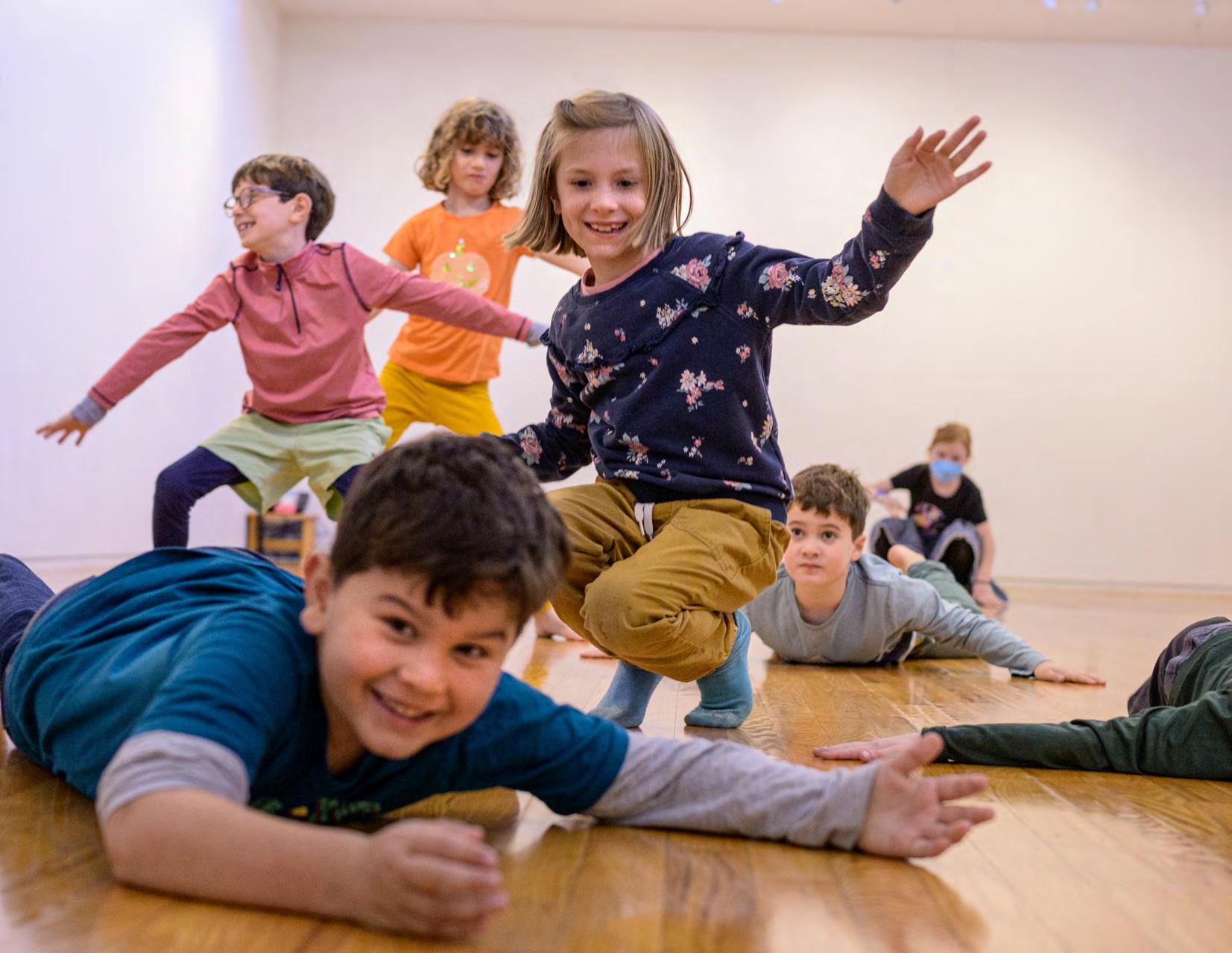
Lower School 2023–2 024
Waynflete’s mission
is to engage the imagination and intellect of our students, to guide them toward self-governance and self-knowledge, and to encourage their responsible and caring participation in the world.
Our aim is to provide a program that combines security with challenge, playful exploration with rigorous expectation, and range of experience with depth of inquiry.
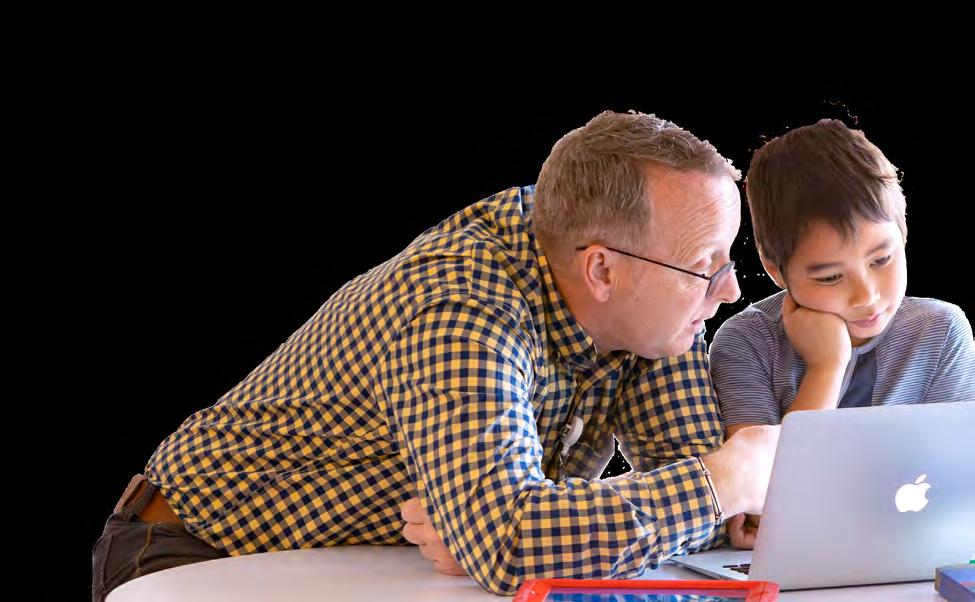
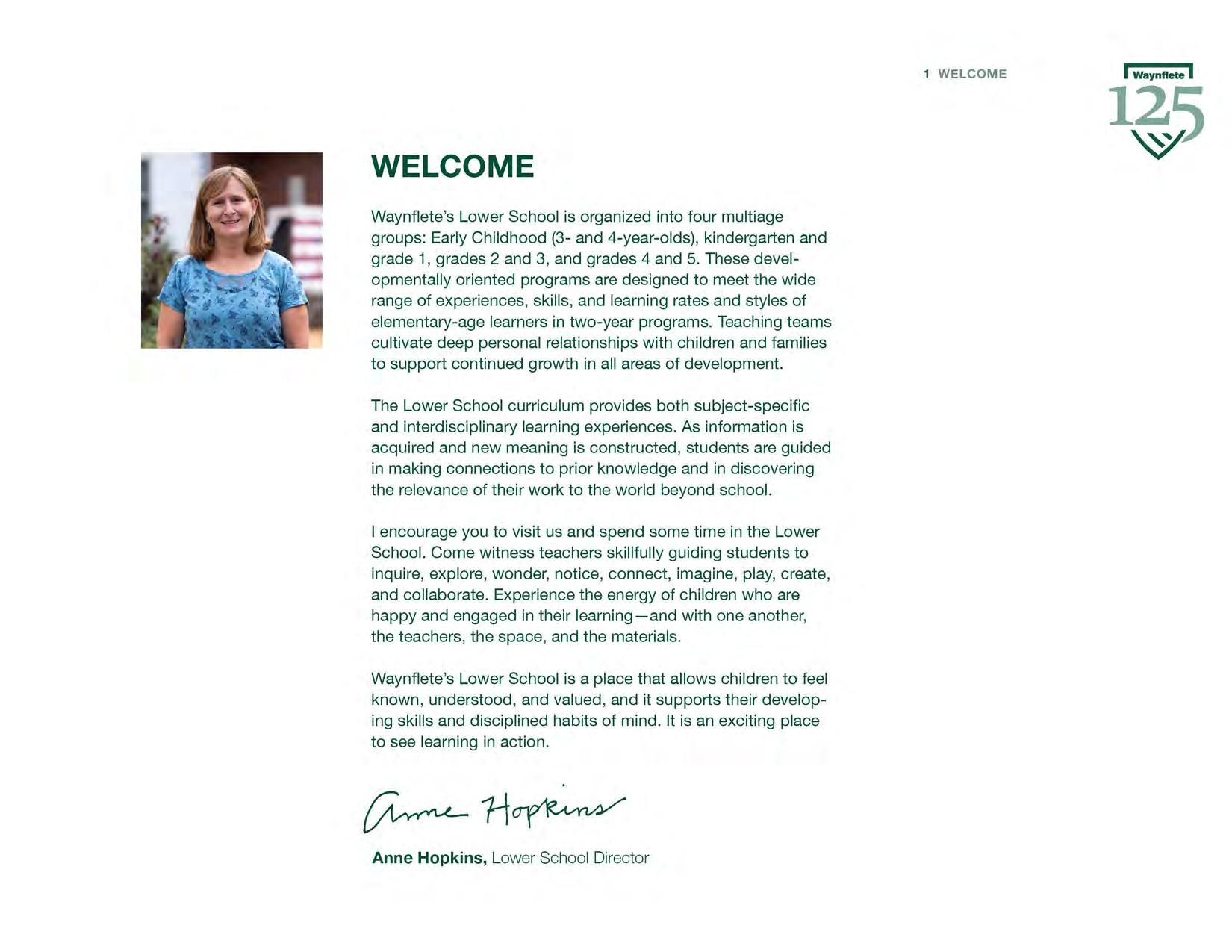
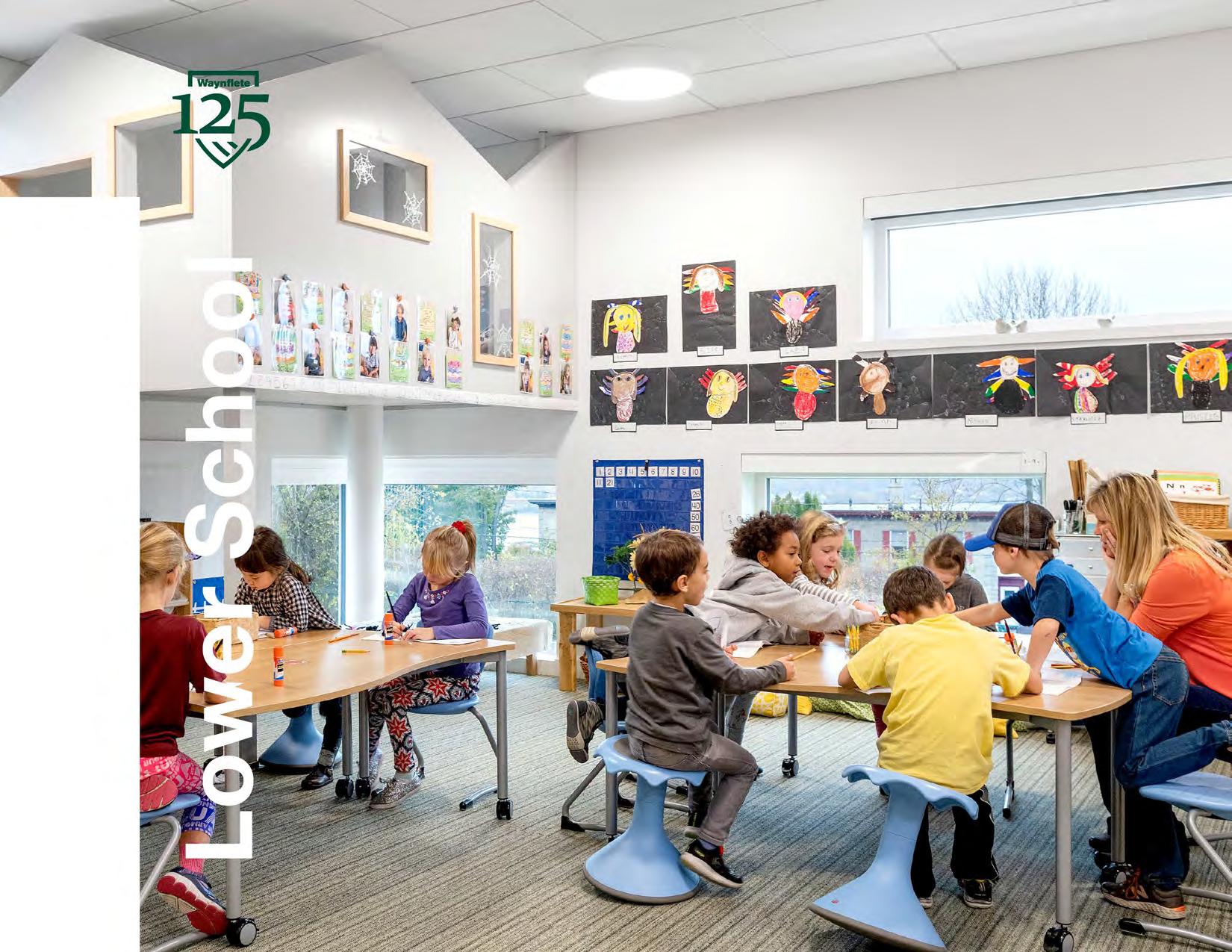
ADVISOR-LED, MULTIAGE PROGRAMS
The Lower School is intentionally organized into two-year multiage groups, each of which is led by four advisors (classroom teachers) who collaborate in curriculum planning and leverage their collective expertise to deliver the core academic program.
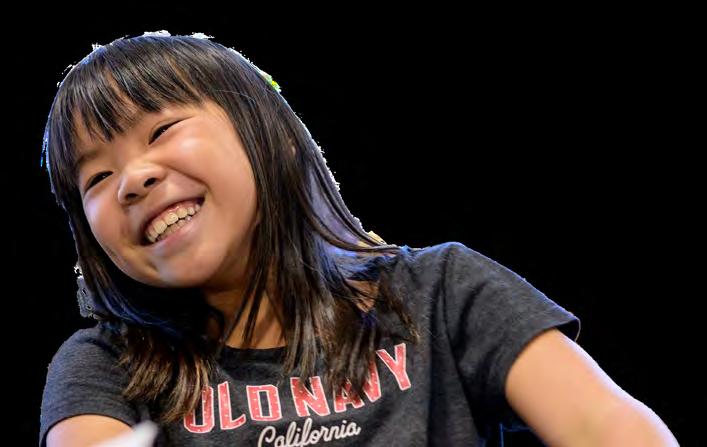
Every student is assigned one of those advisors for their years in the multiage program, an approach that deepens relationships between students, teachers, and families and promotes a lasting collaborative partnership. The multiage groups foster a sense of belonging, as children are embraced by a diverse blend of peers, each at different stages of development. This class composition nurtures empathy, compassion, and deep respect for diversity from an early age. With older students serving as mentors and role models, younger learners are inspired to reach beyond their perceived limitations.
Academic achievement is amplified through personalized instruction, as dedicated educators tailor their teaching methods to cater to the varying abilities and learning styles of each individual. Students flourish in this environment, where collaboration and individual growth intertwine.
"
We believe that every person can be a responsible member of the community and that this sense of responsibility deepens when we treat our students and one another with trust and respect. It is out of respect for each individual that true community arises…By making these connections, we create an atmosphere in which self-confidence, resilience, and strong relationships can grow.”
5 LOWER SCHOOL
WAYNFLETE CORE BELIEFS
INTERDISCIPLINARY CURRICULUM
The Lower School curriculum is designed and delivered by the advisor teaching teams in partnership with department specialists. The interdisciplinary and thematic curricula integrate learning in various subject areas, which fosters deeper learning and comprehension and enables students to make connections across disciplines. For example, instead of studying history, science, and performing arts in isolation, students can explore a topic such as "Maine Maritime" from multiple perspectives and tap into children’s many languages for understanding and communicating. Singing sea shanties, learning about buoyancy by way of a boat design challenge, interviewing a lobster fisherman, and doing a research project on a North Atlantic sea animal—all inform student perspectives and understanding. By connecting different subjects and incorporating hands-on activities, real-world examples, and interactive projects, students feel the relevance of their studies as well as deepening and growing their expertise. Interdisciplinary learning encourages students to think critically and analyze complex problems.
"
Believing that young people are naturally curious about the world, we engage our students with a rich variety of academic and cocurricular experiences, allowing them to explore their own interests, talents, and ideas. Learning flourishes when students are challenged to discover, to create, to take intellectual risks, and to invest themselves passionately in areas both familiar and new.”
6 LOWER SCHOOL
—WAYNFLETE CORE BELIEFS
ENGAGING THE HEADS, HEARTS, AND HANDS OF CHILDREN
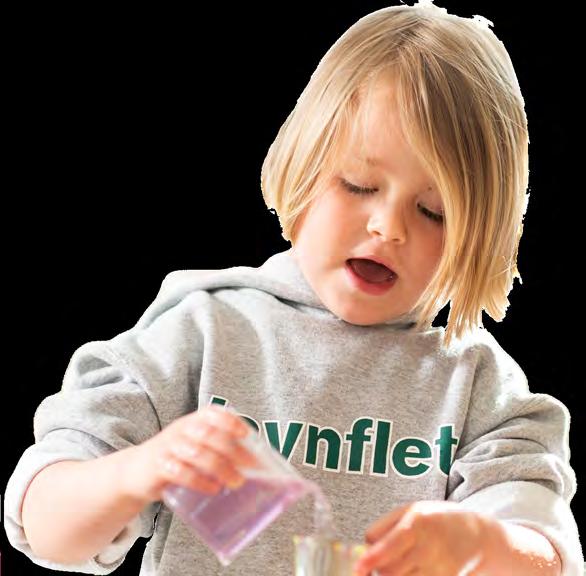
The Lower School is guided by three essential tenets that align with our values: take care of yourself, take care of others, and take care of the environment. With additional influence from the principles of Responsive Classroom, Restorative Practices, and the Social Justice Standards, teachers cultivate an inclusive and respectful classroom environment—and a courageous space—where students are empowered to express their thoughts and opinions and where the values of respect, kindness, and empathy toward others are embraced. Lower School community members engage in explorations and discussions about a wide range of identity markers, including family structure, gender, race, ethnicity, religion, physical ability, socioeconomic status, and learning profile. We challenge ourselves
to create opportunities for exposure to a wide range of diverse viewpoints that exist within and beyond our campus community. As an institution, Waynflete is committed to elevating the voices of underrepresented and marginalized communities to create windows and mirrors for children to see themselves and their families in the world around them, in order to question the assumptions and stereotypes that limit people from realizing their full and true identities, be expansive in our discussions about the full human experience, and grow our capacity to recognize injustice and take action. Helping children see the world through this lens enables them to better understand their own unique identity within the broader context of our rich and diverse community. We are committed to engaging the heads, hearts, and hands of every community member as citizens of the classroom, the community, and the world.
7 LOWER SCHOOL
"
We challenge ourselves to create opportunities for exposure to a wide range of diverse viewpoints that exist within and beyond our campus community.”
—WAYNFLETE CORE BELIEFS
Our Program

Literacy and Communication
Immersed in a language-rich environment, surrounded by invitations and provocations to explore and communicate thoughts and ideas, students have omnipresent opportunities to work on their literacy and communication skills. During daily class discussions, morning meeting circles, collaborative play, and formal and informal presentations, students are honing their skills of communication: listening, speaking, and writing. Scaffolded exercises, explicit instruction, and targeted remediation are all employed to support skill acquisition.
Students are taught to practice the many complex skills of word decoding and language comprehension to become fluent and accurate readers. Reading instruction is focused on a systematic approach to phonemic awareness, phonics, fluency, vocabulary, and comprehension. As their literacy skills develop, students move through the developmental process of recognizing sounds in our language and linking those sounds with letters; blending, segmenting, and reading simple books on their own; and eventually reading more challenging texts.
Writing progresses developmentally from the initial stages of drawing, invented spelling, and dictation to writing independently using phonetic and increasingly conventional spelling. Handwriting instruction, as it is connected to fine motor control, is incorporated into all writing experiences and attends to pencil grip, letter formation, legibility, pacing, and spacing.
Numeracy and Mathematics
With the goal of growing critical thinkers ready to thrive in the 21st century, we support students in developing computational fluency, conceptual understanding, and flexibility of thinking by solidifying a strong foundation in mathematical practices. Informed by the Illustrative Mathematics program, which is aligned with Common Core standards for mathematics, students engage in a wide range of exploration to enhance their number sense and help them tackle the big ideas of mathematics. After the introduction of a topic at the concrete level and practice using visual thinking models via Illustrative Math, abstract representations are developed through collaborative problem-solving exercises and written work. We value student autonomy and regularly provide opportunities for students to extend their learning beyond the curriculum by participating in choice activities, including mathematical games, logic puzzles, math talks, and project-based learning activities. We believe that math is for everyone, and that at the heart of mathematics lies the ability to solve problems using intuition. We aim to deepen students' resilience, reasoning, and communication when analyzing and working on a broad range of learning tasks.
9 OUR PROGRAM
Thematic Studies
Our interdisciplinary EC–5 thematic program is rooted in Waynflete’s mission and centered on the whole child. History, social studies, and science are core components of our thematic studies. Each of our thematic units provides students with a lens into the world while simultaneously deepening their understanding of their own connection to it. As a learning community, we investigate interconnectedness in both natural and human communities on micro and macro levels. There are many entry points to this work that make participation accessible to a variety of learning styles. Students and teachers have endless opportunities to collaborate, ask questions, cultivate and deepen their sense of wonder, and make their own meaning.
Each multiage program is guided by essential questions that are grounded in the Social Justice Standards and its domains of identity, diversity, justice, and action. These domains represent a continuum of engagement in antibias, multicultural, and social justice education, and they invite us to prioritize place-based learning and community connections. Thematic units combine in-depth explorations, projects, field trips, research, books, hands-on learning, and play.
SOCIAL-EMOTIONAL LEARNING
The Lower School’s social-emotional learning (SEL) and wellness programs are aligned and delivered in partnership with the academic program. These programs are rooted in the Responsive Classroom approach to teaching and discipline that focuses on creating a positive and inclusive community along with a learning environment that promotes autonomy, responsibility, and high engagement. The programs aim to promote students’ social, emotional, physical, and cognitive development. Health and wellness goals overlap with personal and social skills, science, social studies, and physical education, and promote the interpersonal skills, scientific knowledge, and social understanding that underlie a healthy lifestyle. Lessons on respect and stewardship are woven throughout the programming.
We turn to restorative practices for cultivating discipline within a nurturing and inclusive environment. In contrast to punitive approaches, which focus on punishment and exclusion, discipline guided by restorative practices emphasizes the principles of empathy and accountability.
10 PROGRAM OVERVIEW
PHYSICAL EDUCATION
Waynflete’s physical education program builds interpersonal skills in a dynamic learning environment. Students build both fine and gross motor skills in a wide variety of activities and sports, and develop the discipline of sportsmanship, honesty, and integrity. Lower School students learn the importance of participating in physical activity each day, as well as the long-term benefits of exercise and physical activity. We encourage every student to challenge themselves daily and put forth an honest effort in each class. Students practice creating an inclusive, welcoming environment where children of all skill levels feel comfortable applying themselves to the best of their abilities. As ambassadors for a healthy lifestyle, we hope to inspire students to appreciate the benefits of hard work in a team-based, inclusive, and challenging environment.
SPANISH
Youth intrinsically fosters a better understanding of the foundations of language. The Lower School Spanish program provides building blocks to understand, comprehend, read, listen to, and respond to information in the target language, in addition to enhancing problem-solving and critical thinking skills. Through art, music, play, games, and projects, our students learn and grow together in a creative and fun environment while also experiencing the fundamentals of the language such as organizing words into sentences, identifying sounds, and counting. Students foster an appreciation for the Spanish language, history, and culture through stories and sharings that show that both our similarities and differences give us strength and identity. Students gain confidence in their ability to learn more of the Spanish language, recognizing that everyone can experience success in a world language.

11 OUR PROGRAM
LIBRARY
The library program is designed to enrich the learning process; satisfy academic, personal, and professional interests; and encourage lifelong learning. The program and the collection both support the curriculum. The Patricia Davis Klingenstein ’47 Library is used by all grade levels and faculty to explore the world of ideas, information, and literature.
Lower School students visit the library regularly for story time, a selection of recreational reading materials, and age-appropriate literacy skills lessons. Students in grades 2–5 also learn the research process through work on independent projects as well as other activities across the curriculum. Students in kindergarten–grade 3 participate in the Chickadee Award program, a Maine children’s choice book award program. Students in grades 4–5 are invited to take part in the Maine Student Book Award program. Novel Engineering is incorporated into the library program, and students engage in the engineering design process while reinforcing their literacy skills.
VISUAL ARTS
The Lower School Visual Arts program is designed to encourage students to develop a personal sense of aesthetics, problem solve visual challenges, and build connections within the school community. Students participate in a range of activities and mediums to expand creative expression and broaden their understanding of the arts in a historical, cultural, and contemporary context. Concepts and skills are taught sequentially and spiral throughout the curriculum to build complexity and depth. Student work is curated and displayed in classrooms, the Klingenstein Library, and the school’s art gallery. Students frequently employ the skills they have developed in the Visual Arts program when they are called upon to share and communicate their learning. Thematic studies, literature, and writing projects often incorporate a visual component. Trips to local museums deepen appreciation and learning connected to art and artists.

12 PROGRAM OVERVIEW
PERFORMING ARTS
Lower School students engage with the performing arts throughout the school year and build foundations in music and movement. They develop both technical and creative skills that encourage imagination, collaboration, and self-confidence through interdisciplinary study. Our weekly Pachanga gatherings provide the perfect stage for creative movement sharings, student leadership, and community engagement. Students demonstrate their understanding of shape and energy as they share a movement study of marine animals or perform concert repertoire for their classmates in the Franklin Theater. Kindergarten and first graders share what they have been learning in their classroom space, while EC students read original compositions to the entire school. Older students have the opportunity to host gatherings and practice speaking to an audience. By the end of the academic year, each program shares the culmination of their skill building in events such as Earth Day Pachanga or the May Day movement gathering.
MUSIC
In the Lower School music program, students develop musical literacy through creative participation in individual and group experiences, gain an understanding of our rich musical traditions and those of many cultures, and develop an appreciation of the connections between music and other forms of artistic expression. Incorporated into these guiding principles are pertinent areas of study as defined by state and national standards for arts education. These include singing, playing instruments, creating, improvising, listening, reading and writing notation, and evaluating and understanding artistic culture. The Lower School music program offers the time and space needed for exploratory play and provides scaffolding to guide students toward musical form and understanding.
13 OUR PROGRAM
"
We believe that diversity is one of the conditions of excellence for our school.” —WAYNFLETE CORE BELIEFS
CREATIVE MOVEMENT/DANCE
The Lower School creative movement program introduces students to the principles and elements of dance and movement education. The exploration of space, shape, energy, and rhythm generates creative and improvisational choices of movement and serves to encourage new ways of expressing ideas when students are participating in activities and movement studies. Strengthening muscles, demonstrating coordination, and improving flexibility are some of the benefits of that flow from practicing basic, challenging, and complex combinations of locomotor and in-place movements.
Dramatic play is a natural part of most children’s lives in the form of make-believe play and creative and multisensory expression. Structured play and drama activities encourage pupils to learn actively and interactively across the curriculum and is ideal for cross-curricular learning. The Waynflete drama program starts in the Early Childhood program with an annual production. Informal drama experiences take place throughout the Lower School and in Enrichment clubs. As an essential arm of the performing arts experience, more drama instruction will be added to the Lower School curriculum over the next two years.
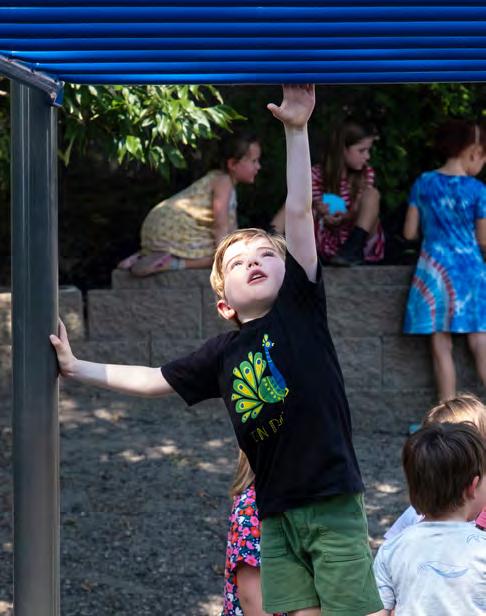 DRAMA
DRAMA
14 PROGRAM OVERVIEW
"
We believe that our responsibility as educators is to collaborate with one another, with our students, with their families, and with the wider community as we strive to fulfill the mission of our school.”
—WAYNFLETE CORE BELIEFS

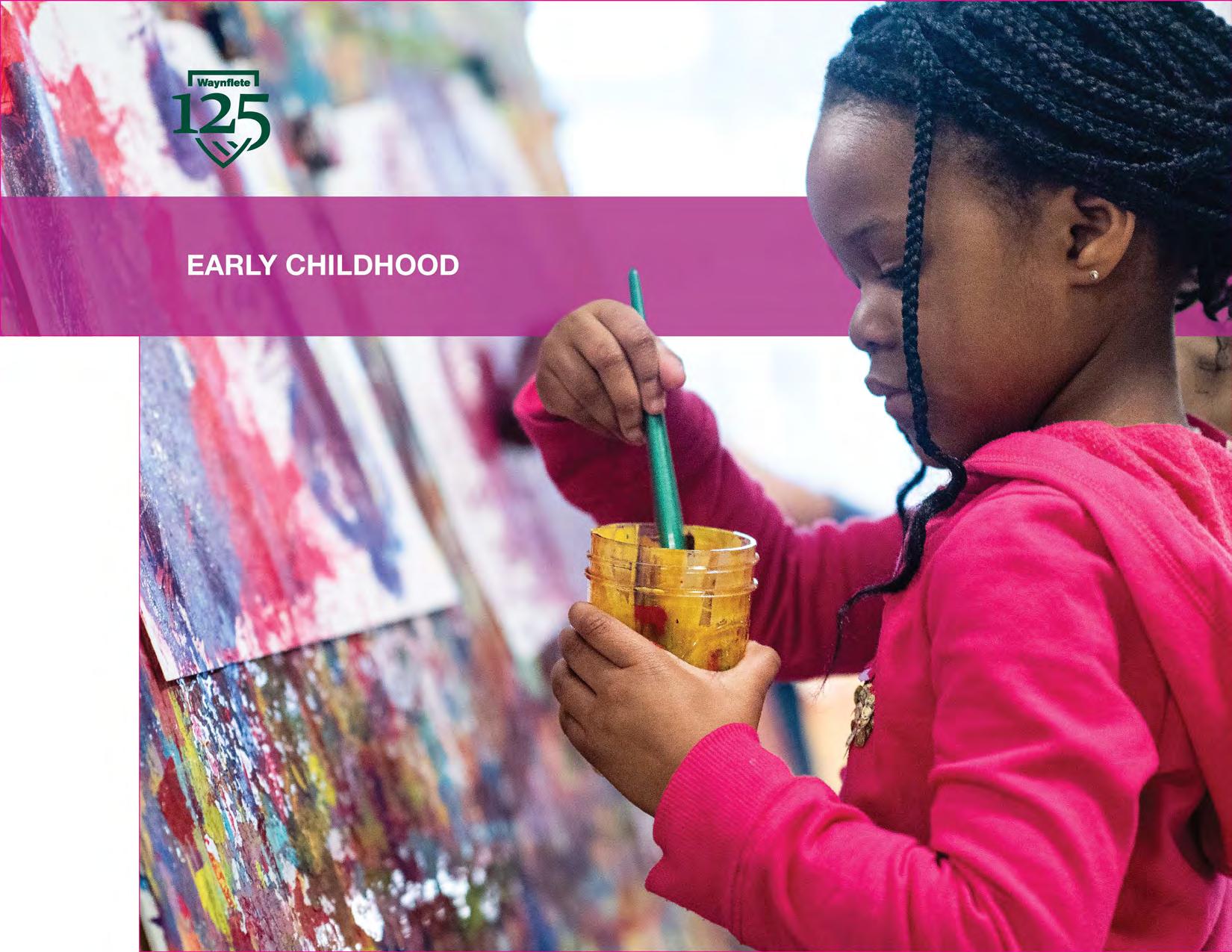
In the Early Childhood program, we deeply value the caring relationships we build with students. We see families as their child’s first teacher and are committed to working in partnership.
We honor the fact that many young children are becoming members of a community of learners for the first time. They are learning how to take care of themselves and each other, to recognize their rights and develop their voices, and to appreciate their responsibilities. Central to our work is empowering young children to develop positive self-identity and agency.
The Early Childhood program is deeply rooted in the Reggio Emilia approach, and teachers collaborate with children to shape the curricular studies each year. These studies encompass a wide range of skill development and subject areas. Early Childhood students bring a sense of wonder and joy to school and we work to translate their excitement and curiosity into ownership of their growth and learning.
17 EARLY CHILDHOOD
Literacy and Communication
Literacy and communication skills are the ways we connect with each other, share who we are, and engage with those around us in order to learn. Children enter the EC program with developing literacy skills—they are communicators through verbal and non-verbal means, and they understand that symbols stand for ideas, which is the underlying concept of reading! EC teachers provide a language- and print-rich environment, giving children diverse opportunities to grow their abilities. Children continue to develop their literacy skills through play and teacher-led activities.
Students engage in listening through stories, poetry, rhymes, and the sounds of language; listening and responding appropriately to others; and remembering stories and information offered throughout the day. Children develop their speaking skills by expressing feelings, ideas, and questions; joining discussions through relevant comments; and developing rich vocabulary through conversations, play, and stories. The skill of reading deepens as students build their knowledge of the world through thematic studies, engage with stories by actively considering characters’ feelings and perspectives, make predictions and inferences, identify names in print, and begin to identify letter names and sounds. Writing for EC students involves telling stories through drawing, pretend play, songwriting, and dictation. With these experiences, students are developing fine motor skills and a functional pencil grip and beginning to develop correct letter formation.
Numeracy and Mathematics
Early Childhood mathematics is rooted in curiosity and lays the foundation for noticing, wondering, and sharing ideas. As students engage with a variety of tasks and experiences designed to spark their inquisitiveness, they become comfortable in communicating their thinking using mathematical language. With the spirit of play at the heart of our instructional practices, children in the Early Childhood program are encouraged to imagine, explore, ask questions, and seek mathematics hidden in the world around them. Informed by the Illustrative Mathematics Curriculum, concrete learning tasks target understanding of the count sequence, solving numerical problems, and classifying objects based on their properties. Our students are encouraged to participate in mathematical discussions where the goal is to generate possibilities rather than to merely seek answers, thereby strengthening their ability to think abstractly and reason collaboratively.
18 EARLY CHILDHOOD
Thematic Studies
Our approach to curriculum development is collaborative and emergent in nature and begins with our teachers’ careful observation of students’ interests, curiosities, and questions. From these observations we develop each year’s unique, studentinspired thematic studies. Student voices and wonderings drive the direction we take in classroom units. We provide concrete and hands-on experiences, explorations on campus and beyond, scientific investigations, connections with the wider community, dramatic play, and artistic expressions. We weave our thematic studies into free choice times with materials and provocations set up in the classroom. Students have the opportunity to develop individual, selfexpressive passions, and we integrate these topics into structured, teacher-led project times.
In the past, these studies have included a wide range of topics such as spiders, dance, stone walls, changemakers, carnivorous plants, and waterfalls.

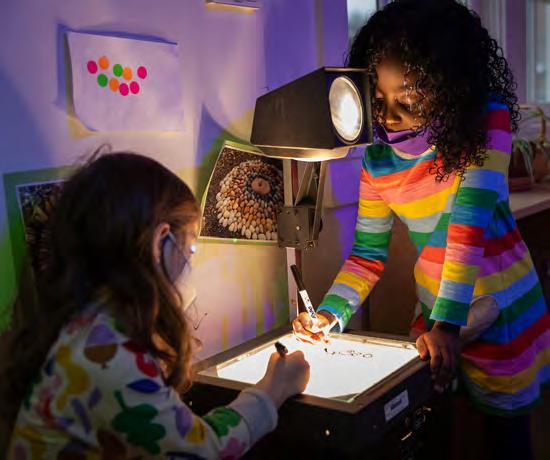
19 EARLY CHILDHOOD
"Students have the opportunity to develop individual, self-expressive passions, and we integrate these topics into structured, teacher-led project times.”
SOCIAL-EMOTIONAL LEARNING
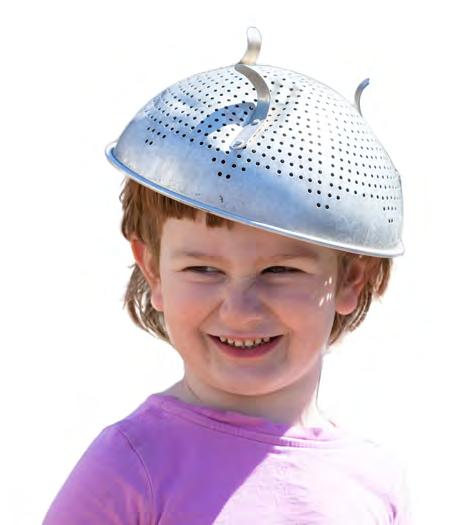
The Early Childhood social-emotional learning (SEL) program focuses on nurturing the emotional well-being, interpersonal skills, and self-awareness of young children. Students work to identify and express their emotions and build empathy as they understand the emotions of others. Self-regulation is another area of focus. Students practice various strategies such as deep breathing exercises, relaxation techniques, or simple mindfulness practices that help them regulate their emotions and cope with challenges. Early childhood is an ideal time to develop social skills and learn how to build positive relationships. Children also engage in decision-making scenarios where they learn to consider the consequences of their actions, evaluate alternatives, and make choices that align with their values and the well-being of others. Social-emotional learning is central to all learning in early childhood and incorporated into students' daily play, guided discoveries, and project time.
PHYSICAL EDUCATION
The Early Childhood PE program celebrates the opportunity to move in many different ways. As students explore movement concepts and a dynamic moving environment, they begin to build spatial awareness and comfort in moving in large spaces. We establish safety and behavioral expectations in the space and learn to be “smart movers” in a variety of collaborative skill-building activities. Students develop both fine and gross motor skills and refine locomotor movements and manipulative skills. Students are encouraged to try new things that challenge them physically, socially, and emotionally.
SPANISH
Students in Early Childhood engage in the foundations of the Spanish language via two primary functions of language learning: listening comprehension and speaking. They are exposed to both the language and culture through books, songs, and games. Class occurs once a week in the format of a general meeting, during which students and advisors are encouraged to participate in a variety of activities in Spanish.
20 EARLY CHILDHOOD
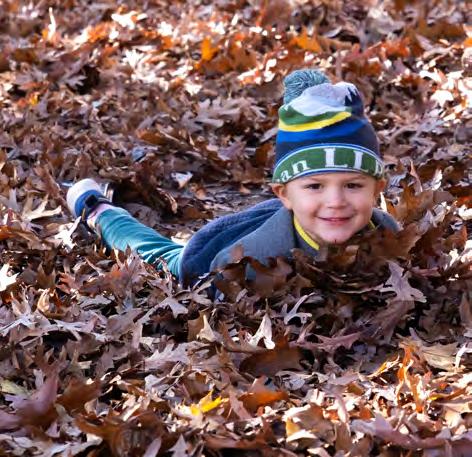
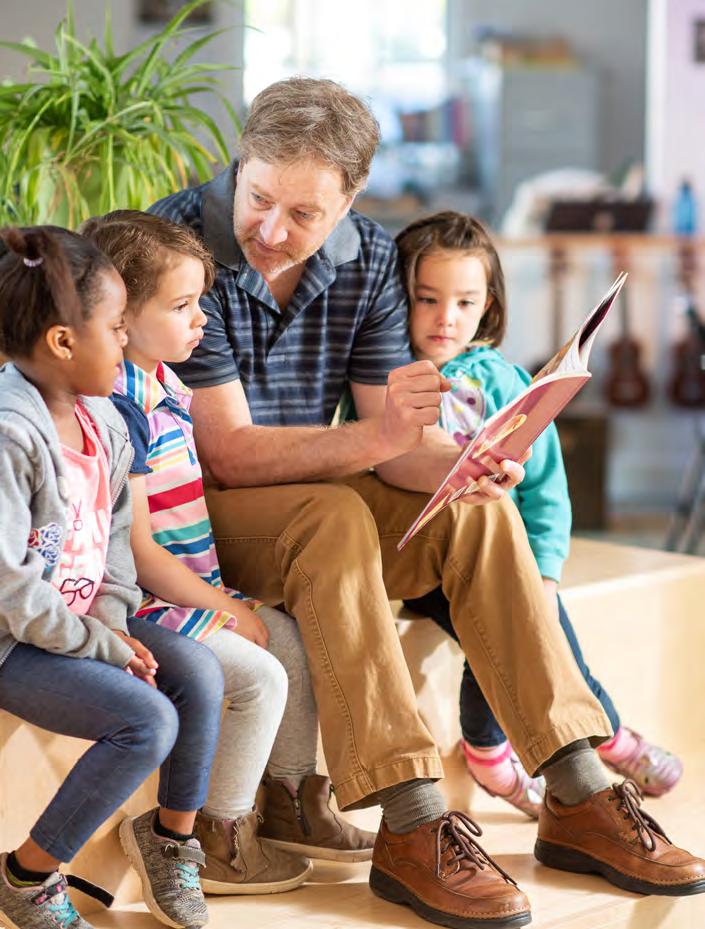

21 EARLY CHILDHOOD
LIBRARY
The library program supports the Early Childhood emergent curriculum by locating and providing resources to inform classroom teaching and learning. Students are introduced to the library as a space where great stories—as well as books that help them learn—can be found. As the year progresses, EC students begin to visit the library in smaller groups to select books to share in their classroom. EC teachers and the librarian provide opportunities to listen and respond to literature and to begin to understand the relationship between illustrations and text.
VISUAL ARTS
In EC, the classroom art studio is always available to students for informal work. Choice time, as well as the more instructional project time, provide students with the opportunity to express themselves through various visual media in both two and three dimensions. Embracing the idea that art is a form of communication and self-expression for all people, the goal is to instill an appreciation for the artistic efforts of students and of others and to understand that there are many potential approaches to art.
MUSIC
The EC classroom conservatory helps nurture a love of and appreciation for music in all students. Children are exposed to a variety of musical genres and are encouraged to use string and percussion instruments to express themselves through original lyrics and melodies. Students explore musical skills such as keeping a steady beat and distinguishing between low and high pitches. They share their compositions with classmates and have the opportunity to learn how to be a member of a band.
CREATIVE MOVEMENT/DANCE
In creative movement class, students are introduced to the elements of movement and a variety of activities promoting the development of spatial awareness, imagination, and muscular strength. They explore movement through storyline studies and facts about the environment. Students learn through rhythmical and imaginative movement games, express ideas through movement, and develop freedom of movement through improvisation.
22 EARLY CHILDHOOD
"Students are introduced to the library as a space where great stories—as well as books that help them learn—can be found.”
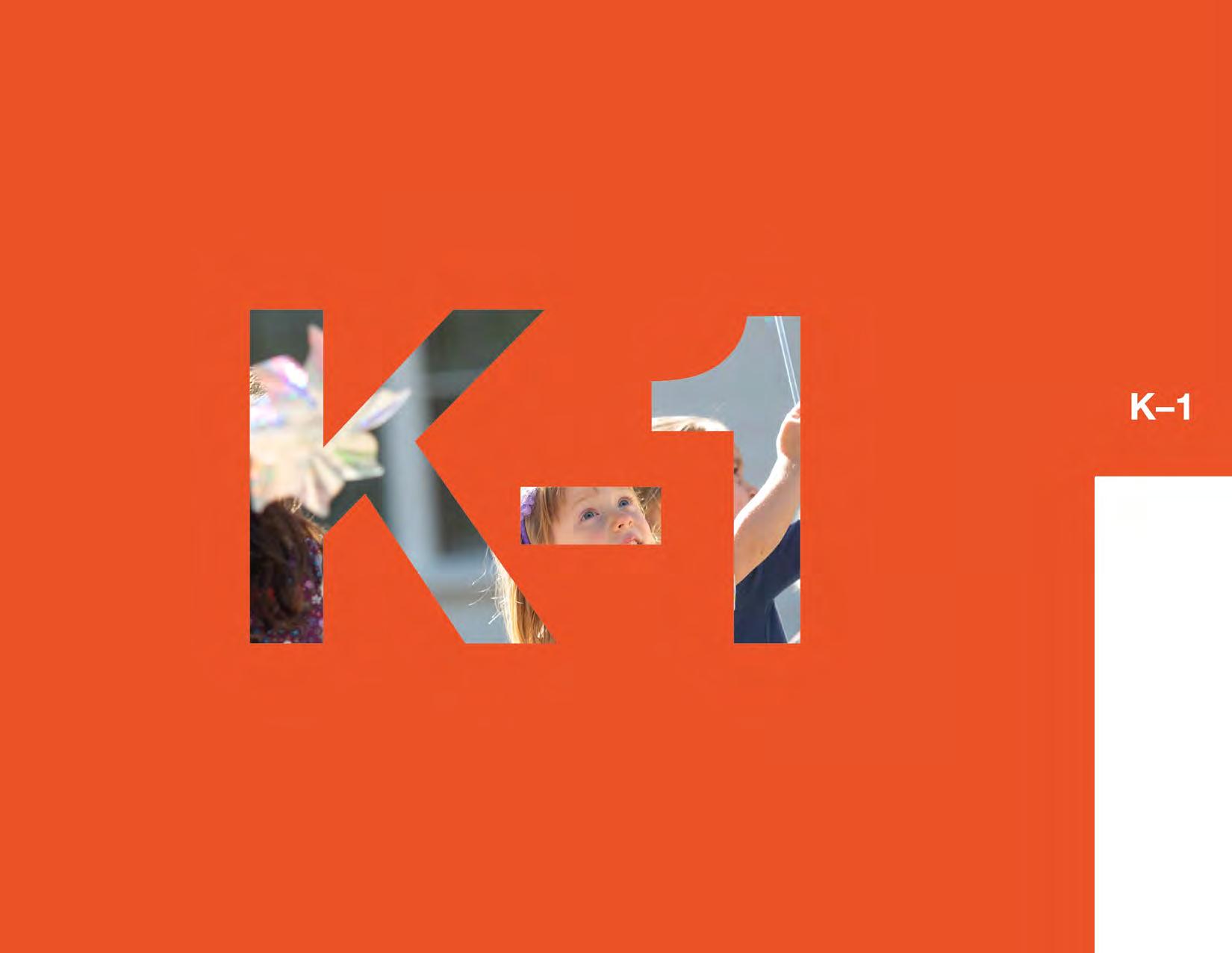
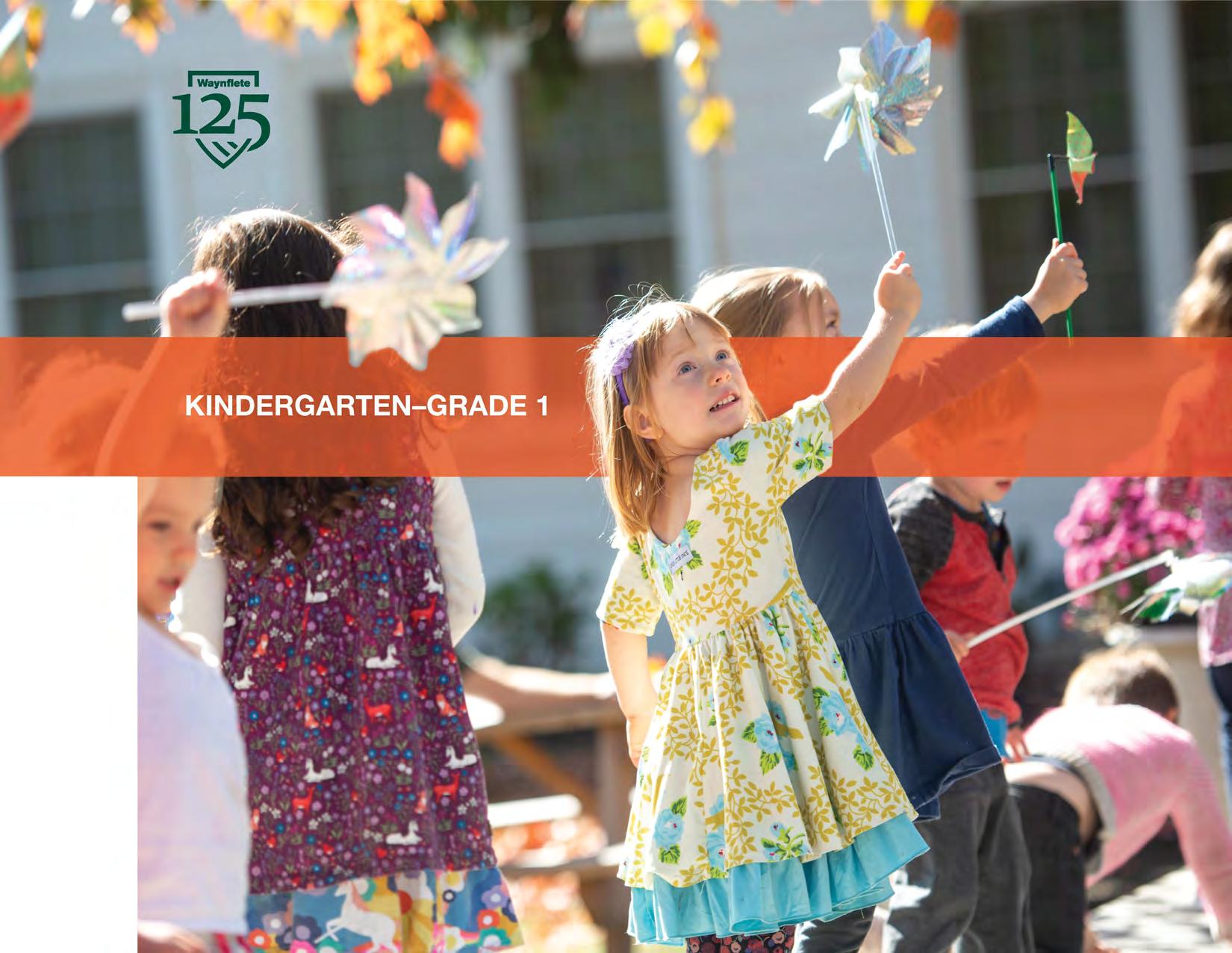
The Lower School’s K–1 program helps children develop self-confidence, a love for learning, and respect and appreciation for themselves, others, and their environment.
We emphasize the development of social skills and encourage children to cooperate with each other, make good choices, and take responsibility for their own learning. Our curriculum is designed to accommodate the wide range of learning styles and skill levels that children bring to the classroom. Learning opportunities are presented in a supportive, stimulating, and creative experiential setting. Individual, small-group, and wholeclass activities are used throughout the day.
25 K–1
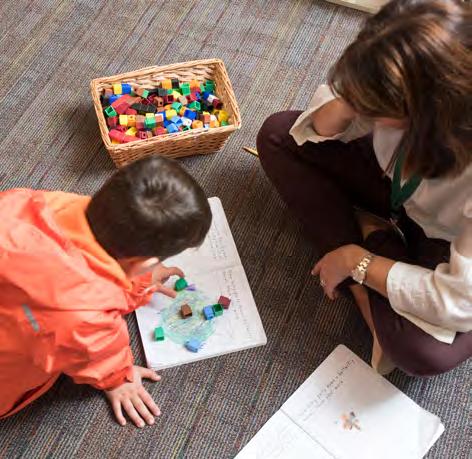

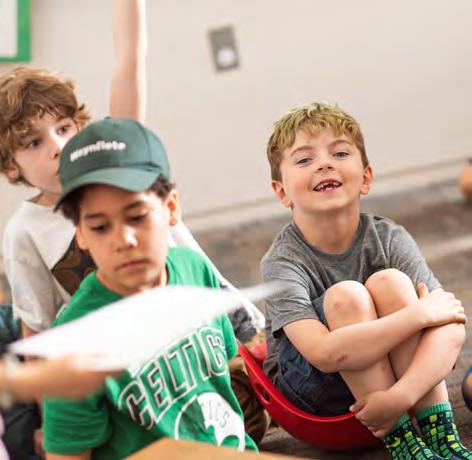
26 K–1
Literacy and Communication
The K–1 language arts program encourages students to develop a love for words and books and gain confidence in their own abilities. The K–1 classroom is a language-rich environment that invites students to engage in all aspects of literacy development: listening, speaking, writing, and reading. Opportunities for listening and participating in conversations, directions, and stories are presented every day. Time is allocated for students to join discussions, solve problems, respond to questions, and share ideas and experiences within the group. As associations are formed between letters and sounds, children begin to write independently, using phonetic spelling and recording the words they know. As their literacy skills and confidence grow, children start reading books that support their further development as readers. All students receive the foundational and sequential phonics instruction that enable them to hear and manipulate sounds in words and recognize letter names and sounds. As students use their knowledge of phonics to read words, they decode increasingly complex text to read sentences, short passages, and books. Whole-language activities are also an essential part of the experience. Students build vocabulary through language-rich texts and thematic exploration. Over time, students independently use phonemic awareness, invented spelling, and handwriting skills to communicate their ideas in writing.
Numeracy and Mathematics
Building on the innate habit of wonder seen within this age group, K–1 students develop their use of mathematics through playful exploration and guided discovery. Using student-instructional routines from the Illustrative Mathematics curriculum, we encourage individuality by placing value on mathematical reasoning. In addition to developing number sense through concrete learning tasks, students in K–1 are asked to model, draw, and record their understanding using a variety of modalities, deepening their conceptual knowledge as they present their ideas. Students extend the count sequence; practice using numbers flexibly to estimate and solve numerical problems; analyze and compose 2D and 3D shapes; interpret, solve, and create story problems; and measure objects using place value independently and in collaboration with their peers. We believe mathematics is a language and we support our students in finding their unique voices and understanding the voices of others.
27 K–1
"
K-1 students develop their use of mathematics through playful exploration and guided discovery.”
Thematic Studies
The K–1 science and social studies curriculum is organized around units of study that reflect the interests of the children and their teachers. The curriculum is rooted in four essential questions: What do we/living things need to live a happy and safe life? What are the needs of others to live a happy and safe life? What things get in the way of living a happy and safe life? What can we do about it?
Thematic studies are interdisciplinary in nature and incorporate studies of the natural world (science) and being a part of different communities (social studies). Every year, K–1 students examine an animal in its habitat, integrating both disciplines in one study. The science-grounded studies of the natural world are launched by children sharing what they notice and wonder, which in turn informs their questions, observations, and interests. During each study, students have opportunities to build, take apart, sort, observe, compare, question, and experiment.
K–1 students engage in studies that support their growing sense of identity and diversity through themes: Myself and My Family and Myself and My Community. Through stories, discussions, activities, meetings, and play, children build social skills and develop an understanding of what it means to be a member of a community.
SOCIAL-EMOTIONAL LEARNING
Kindergarten and first-grade students are beginning to develop self-awareness and self-regulation and learning to recognize and express their feelings in a healthy manner. Students are guided to identify their strengths, celebrate achievements, and develop a growth mindset. The K–1 day is filled with opportunities for cooperative learning, group projects, and collaborative activities that foster positive relationships and teamwork. Guided by the Social Justice Standards, students explore diverse perspectives and experiences and practice perspective-taking. Guided instruction for active listening, effective communication, problem-solving, and conflict resolution help students develop stronger community relationships. Values such as kindness, respect, honesty, responsibility, and fairness are foundational to our community culture.
PHYSICAL EDUCATION
K–1 students focus on teamwork and collaborative games. Communication, relationships, and integrity in the classroom comprise a large portion of the learning outcome. Students explore different ways to challenge themselves in team-based settings where they are required to work together. Respecting others, respecting space, and respecting ourselves are introduced as learning philosophies. Gross motor skills are developed and put into action in a variety of different sports and activities. Students learn how to safely use a diverse range of equipment and take on responsibility in cleaning up and keeping our space tidy.
28 K–1
SPANISH
Students in the K–1 program engage in the foundations of the Spanish language through two primary functions of language learning: listening comprehension and speaking. Children begin to develop verbal understanding of the Spanish language through movement, play, connection with culture, and a wide range of activities. In weekly classes, students begin to identify Spanish words and phrases and make cultural connections to their lived experiences.

LIBRARY
The library program supports and extends the K–1 classroom literacy program. Students in K–1 visit the library weekly to listen and respond to read-alouds, including books that support thematic studies, as well as nominees for the Chickadee Award, a Maine children’s choice literature program that develops an appreciation of outstanding writing and illustration in current children’s picture books. Students select books that support their emerging literacy development and their interests. As they browse the collection, they begin to understand how the library is organized. Students may also visit the library individually during choice time.
29 K–1
VISUAL ARTS
Students in K–1 art use their individual perspectives to express emotion, observation, and discovery. Motor skills are refined through a variety of mediums and methods, including paint, clay, drawing materials, printmaking, and collage. Students are encouraged to trust their intuitions and be adventurous. Historical and contemporary artists are integrated into the curriculum, cultivating an awareness of art as a universal language.
Over the course of the year, students engage in color theory (using primary colors, mixing secondary colors, and discussing how color relates to feeling or mood); introductory clay and glazing techniques; and printmaking. They learn to define realistic and abstract art styles, illustrate narrative stories, and paint with tempera and watercolors. They will be introduced to art elements (including line, shape, color, form, and texture) and using geometric shapes to form realistic images.
MUSIC
K–1 students focus on identifying opposites, such as fast and slow, loud and quiet, and high and low, and practice using their singing and speaking voices. Musical vocabulary is introduced as each student becomes more comfortable identifying what they hear. Each class uses singing games, stories, and listening examples to help students become more comfortable performing on their own and in groups. Students perform and practice the first few notes
of the solfège scale, along with basic rhythms. The program culminates in notating known songs along with composing and performing short melodies.
Over the course of the year, students develop a repertoire of singing games and activities; play hand drums, mallet percussion, and other percussion instruments to develop soundscapes and accompaniments; compose and perform short patterns individually and in groups; and experience music from various cultures
CREATIVE MOVEMENT/DANCE
K–1 students learn about the elements of dance through movement exploration, collaboration, and improvisation, and through activities that strengthen movement skills and encourage creativity. As they build on basic locomotor steps and create combinations and movement patterns, children strengthen muscular coordination and motor skills as well as communicate concepts and ideas through movement. Students create short movement studies (compositions) using themes that help them make connections to their classroom curriculum. They build self-confidence and an appreciation of each other’s identity and creativity.
30 K–1
"Students build self-confidence and an appreciation of each other’s identity and creativity.”


The Lower School's 2–3 program emphasizes individual growth, collaborative inquiry, and student engagement in both academic and social realms.
We foster skills and values that serve children their entire lives—a love of learning, openness to new experiences, growing independence, and respect for others. One of the program’s primary goals is to create a community of learners in which children are able to learn from one another, their teachers, and the world around them. Students develop a sense of independence and responsibility in solving conflicts with peers, contributing positively to the community, and taking an active role in caring for their environment.
33 2–3
Literacy and Communication
Helping to develop the skills to read independently and encouraging a love and habit of reading are at the heart of the 2–3 language arts program. Children build their reading skills and appreciation through an immersion in print: reading orally with a teacher; literature groups; weekly library trips; independent quiet reading; readalouds; and reading schedules, charts, and other printed material posted around the room. Students engage in literacy activities and differentiated small group instruction, which are designed to build their literacy skills in phonics, accuracy, fluency, vocabulary, and comprehension. Students are taught to practice the complex skills of word decoding and language comprehension to become accurate and fluent readers.
Writing is emphasized throughout the 2–3 program. Children write in journals and scrapbooks, respond in writing to their reading material, write formal letters, complete written assignments in science and social studies, and participate twice weekly in writing workshop (where grammar instruction primarily takes place). To focus on the development and expression of ideas, phonetic spelling is encouraged in writing. Conventional spelling is taught through phonics and word study, and correcting for conventional spelling is included in the editing process.
Workshop classes are designed to help students develop their writing skills and think of themselves as authors. The writing process includes generating topics, writing drafts, conferencing, and editing.
Children enrich their writing by engaging in wordplay, exploring a variety of genres, considering elements common to most stories, and studying writing by other authors. Sharing and learning how to receive one another's work thoughtfully are also important goals of the writing class.
Numeracy and Mathematics
Having previous experience working with addition and subtraction expressions, 2–3 students further refine their mathematical practice as they extend their understanding of place value and number operations. With increased complexity, children develop their ability to reason using visuals, articulate their strategies in a cohesive way, and model their thinking with manipulatives. With the Illustrative Mathematics curriculum as a foundation, computational fluency is emphasized along with interpreting the procedures and representations of others. Our goal is for students to develop confidence in their ability to solve problems intuitively, work collaboratively, and share their ideas in ways that make sense to others. In addition to exposing learners to methods that strengthen conceptual knowledge, we believe in providing opportunities for play to serve as a way to increase number flexibility and factual fluency. We aim to create a mathematical mindset culture where students find value in their ability to think, discuss, make mistakes, and support each other in understanding.
34 2–3
Thematic Studies
Students in Waynflete’s 2–3 program explore science and social studies topics by bringing together the perspectives of a range of disciplines, including art, language arts, and the performing arts. These interdisciplinary units are rooted in four essential questions: What is my space and place, and how do I move between places? How do other people move and communicate across spaces? What affects where we live (or where we take up space)? How do we sustain the places where we live?
Each year in 2–3 begins with a Maine-based thematic study, alternating between the Wabanaki of Maine and a Maine maritime unit. These themes invite students to consider the community beyond the walls of Waynflete and experience being scientists and social scientists as they examine the past, present, and future of the state of Maine. During their time in 2–3, students engage in topics of environmental sustainability, design thinking, marine biology, genetics and reproduction, and independent research.
SOCIAL-EMOTIONAL LEARNING
Second and third graders grow in self-awareness by expanding their emotional vocabulary and enhancing their ability to recognize and label their own emotions and those of others. Teachers introduce strategies for self-regulation, impulse control, and stress management and help students develop resilience by teaching problem-solving skills, coping strategies, and positive self-talk. This age group has a keen sense of fairness,
which we capitalize on by introducing the concept of social justice. As students deepen their understanding of the tenets of identity and diversity, they are called to action to interrupt systems of injustice. In scenarios from literature or social studies, the social-emotional learning curriculum, and real-life examples, students discuss the consequences of choices and actions and consider the impact of decisions on themselves and others. Practicing the art of negotiation and developing problem-solving strategies help students navigate interpersonal challenges.
PHYSICAL EDUCATION
Students in 2–3 explore a range of activities that require a competitive outcome. We learn how to win and lose responsibly in a diverse environment of activities and sports. Students learn about the benefits of physical activity, and we begin to understand the importance of elevating heart rate and physical activity on a daily basis. Children learn to compete in a variety of sports and activities that require them to behave responsibly and respectfully and to exemplify good sportsmanship and honesty. Students build confidence in stepping outside their comfort zone, trying new things, and making mistakes.
35 2–3
"Themes invite students to consider the community beyond the walls of Waynflete WAYNFLETE MISSION
SPANISH
Students in 2–3 engage in the foundations of the Spanish language via three primary functions of language learning: listening comprehension, speaking, and reading. They build on their foundation of Spanish during weekly classes as an advisory group. The program focuses on accumulating vocabulary, although students are also asked to participate in short conversations and are expected to follow directions in Spanish. Songs and games continue to serve as a base for learning vocabulary, and students participate in role-playing activities, hands-on projects, and in-depth cultural studies more frequently. By the end of the school year, both second and third graders read short, simple novels in Spanish.
LIBRARY
2–3 students visit the library weekly by homestation, and individually during quiet reading time. In addition to listening and responding to literature, they continue to develop research skills and knowledge of library arrangement and book or resource location by learning to use the catalog and library call numbers. This enables students to find books that aid in literacy development and also supports their research of independent project topics. Children develop independence in selecting books that interest and challenge them in a variety of genres and formats. 2–3 students also participate in the Chickadee Award program, a Maine children’s choice literature program that develops an appreciation of outstanding writing and illustration in children’s picture books.
VISUAL ARTS
Students in 2–3 art explore a variety of mediums and techniques to create artwork using imagination and observational skills. Using personal insights to problem solve cultivates an awareness of multiple approaches to resolving challenges. The curriculum includes paint, clay, drawing materials, printmaking, and collage. Students are encouraged to make positive choices in time management, peer interaction, and classroom stewardship. Historical and contemporary artists are integrated into the curriculum, cultivating an awareness of art as a universal language.
Over the course of the year, students engage in color theory using primary colors to mix secondary and neutral colors, and reinforcing the ways in which color relates to feeling or mood; portraiture; sculpting in clay; printmaking; and painting with tempera and watercolor. Students incorporate art elements into projects, including line, shape, color, form, and texture. The program reinforces the definitions of realistic and abstract art styles, and students explore the use of geometric shapes as the basis for drawing realistic images.
36 2–3
"Historical and contemporary artists are integrated into the curriculum, cultivating an awareness of art as a universal language.”



37 2–3
MUSIC
2–3 students experience the pentatonic scale through folk melodies and games from the Western tradition along with many cultures from around the world. Children pair notes with quarter, eighth, and sixteenth note rhythms to compose repeating patterns. Each class works collaboratively to identify note names and common musical symbols in Western music notation along with other styles of written and aural music. As a culmination of their creative work, students work individually and in groups to perform their compositions on instruments including xylophones, metallophones, and drums.
Throughout the year, students sing folk melodies and identify pitch collections, play known songs on xylophones and metallophones, notate and compose using known rhythms and pitches, and choreograph short dances to known songs.

CREATIVE MOVEMENT/DANCE
2–3 students explore a wide range of movement activities designed to encourage muscular development, increase coordination, and inspire creativity. Creative movement encourages students to be active, innovative, collaborative, and expressive. The weekly routine includes practicing stationary movement patterns and building basic and challenging combinations of traveling steps. Themes and concepts from the classroom curriculum are frequently intertwined in dance activities and the creation of movement studies. Through the exploration of the dance elements—space, shape, energy, and rhythm— students express artistic ideas, connect to classroom topics, expand their selection of movement choices, and tap into their imaginations.
38 2–3
"Creative movement encourages students to be active, innovative, collaborative, and expressive.”
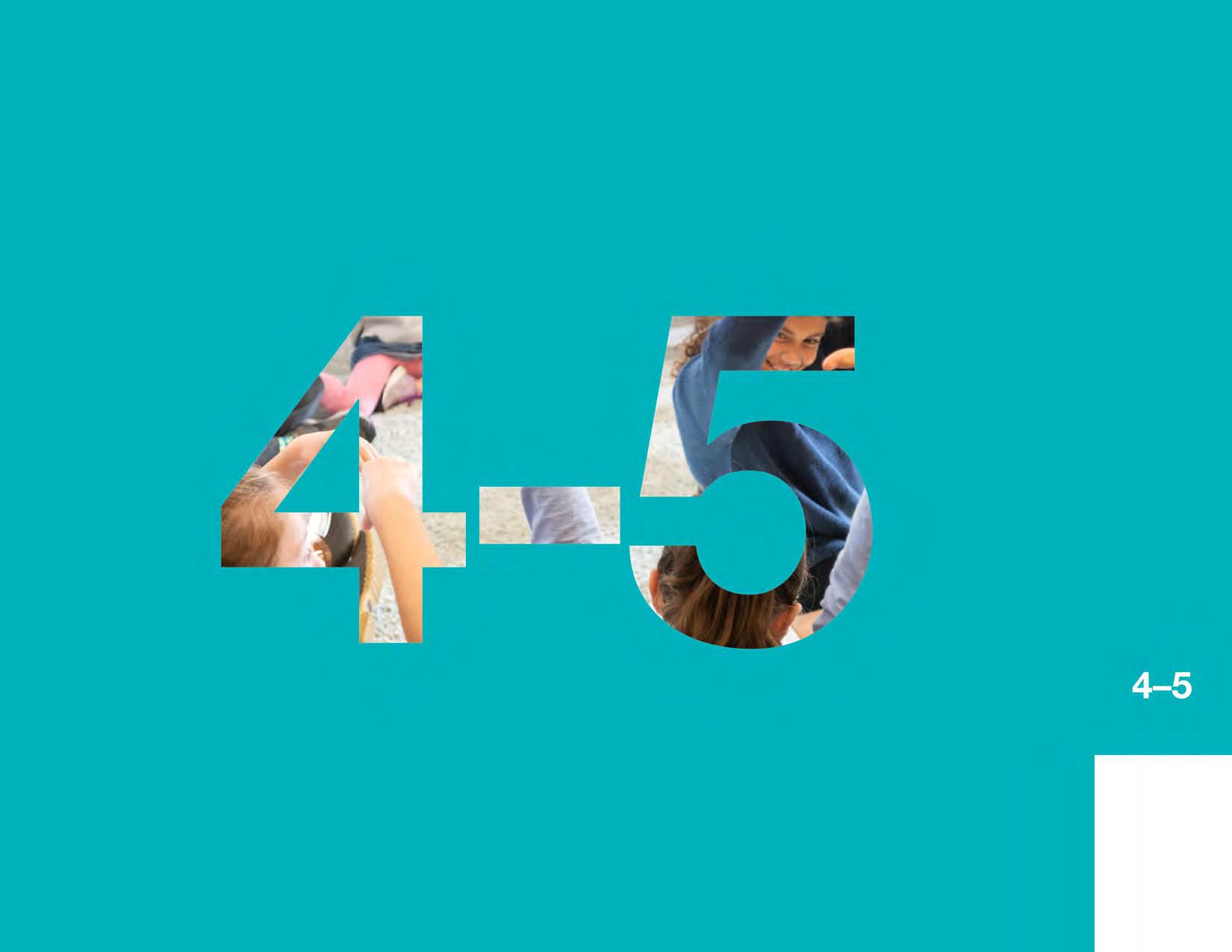

The 4–5 curriculum offers an interdisciplinary perspective, organizing academic disciplines around central themes of study.
Working both independently and collaboratively, 4–5 students are responsible for assignments of increasing length and complexity.
Teachers explore the learning process with children, helping them build awareness of their own unique strengths and challenges while developing effective strategies for academic work.
Students learn to set goals and reflect on their progress. We cultivate the qualities of leadership, empathy, perspective-taking, collaboration, and community responsibility.
Four essential questions guide our work in 4–5: What is my relationship with the world and its communities and ecosystems?
How are we nourished by our communities and ecosystems?
How do we cause harm to communities and ecosystems? How do I take action to repair and prevent harm so all will thrive?
41 4–5
Literacy and Communication
Literature classes in 4–5 encourage each student to experience reading for a variety of purposes while exploring diverse genres and making personal connections with the text. A focus on fluency is integrated across all aspects of the literacy program, building a bridge between word recognition and comprehension. As reading becomes more automatic and fluent, students are better able to focus on what the text is saying, inviting them to make connections between what they are reading and their own background knowledge.
Literature groups, book talks, read alouds, and independent reading broaden interests and introduce conventions such as plot, character, and setting that are used to analyze literature. The program aims to foster a love of reading, increase stamina for the skill, and expand vocabulary. Students are taught higher-level comprehension and critical thinking skills, including inferring, evaluating authors' craft, reading critically, synthesizing information, and expressing empathy for individuals.
Students in 4–5 learn the art of writing through inspiration gained by their own lived experiences, analyzing the work of authors through mentor texts and through direct instruction. The writing program provides a scaffolded support system for all writers and emphasizes the writing process: gathering ideas, revising, conferencing, editing, writing multiple drafts, and publishing. Students receive whole-class,
small-group, and individual instruction to engage with content and to better provide for the individual needs of each student. Examples of writing workshops include letter writing, note-taking, book reviews, nonfiction narratives, comics, poetry, and independent research projects. Spelling and grammar are honed within the word study curriculum, where students focus on individual spelling patterns pertaining to their own skill level.
Numeracy and Mathematics
Students in 4–5 mathematics work with increased efficiency, moving away from modeling with manipulatives to using algorithms and generating visual representations and written explanations when solving problems. Having developed an understanding of mathematical practices, students regularly collaborate to tackle complex tasks and share their reasoning in discussion, deepening their conceptual knowledge of previously learned ideas. In addition to using the four operations in varied contexts, children extend their understanding of the number system to include work with fractions and decimal equivalence and operations. We believe that deep understanding comes from engaging with a variety of perspectives, and we hold students accountable for stretching themselves to show more than one method when problem solving. Students strengthen their communication skills and sense of self as mathematicians, making them well poised for the collaborative expectations of Middle School and the various avenues of math learning offered in Upper School.
42 4–5
Thematic Studies
The 4–5 science and social studies curricula are thematically based and focus on big concepts and inquiry-driven learning experiences that incorporate multiple topics. Using a cross-curricular approach, the program nurtures children’s natural curiosity about themselves and the world around them. Students are engaged in interdisciplinary, experiential activities that help them develop proficiencies, including conducting experiments and historical analysis, communicating what they learned, and empathizing and reflecting. Through projects, primary and secondary sources, hands-on experiences, community connections, time in our classrooms, and field trips, students gain awareness of our environment and our world. Thematic studies in 4–5 include: Local Foods: Farm to Food, Westward Expansion: Land and Culture, Immigration, and Simple Machines.
SOCIAL-EMOTIONAL LEARNING
The focus of the 4–5 social-emotional learning program is to support students as they navigate their emotional well-being, build positive relationships, and succeed academically. Continuing to grow in selfawareness and self-management, students engage in reflective activities and journaling, goal setting, and problem solving. They also develop tools for stress management and emotional regulation. The program prioritizes social awareness by fostering empathy, understanding, and respect for diverse perspectives through collaborative projects and discussions,
literature, and social studies exploration. The principles of restorative practices emphasize responsible decision-making by teaching students to make ethical choices, consider consequences, and evaluate options thoughtfully. By promoting relationship skills, the program encourages effective communication, active listening, and conflict resolution, enabling students to build positive connections and thrive in a collaborative environment. There are ample opportunities for students to practice these skills through role-playing, group activities, and community service projects, ensuring the application of social-emotional learning principles beyond the classroom.
PHYSICAL EDUCATION
Students in 4–5 have built a solid foundation of fine and gross motor skills and have learned to apply these skills to different sports and activities in a responsible manner. We continue to develop sportsmanship, honesty, and integrity in our students, and they begin to take ownership through their ability to compete and win and lose with grace. Learning outcomes are based mainly on effort, how we treat others, and how we handle adversity in the classroom. We teach our students to be resilient to the challenges that they will face. The 4–5 curriculum also explores the cardiovascular and respiratory systems and how bodies respond to exercise. Sports are more of a focus at this grade level, with the intention of inspiring students to sign up for sports in sixth grade.
43 4–5
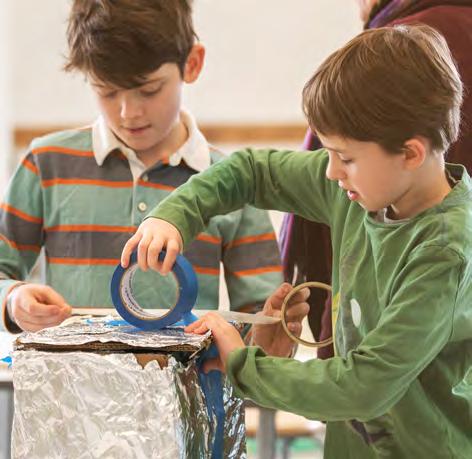
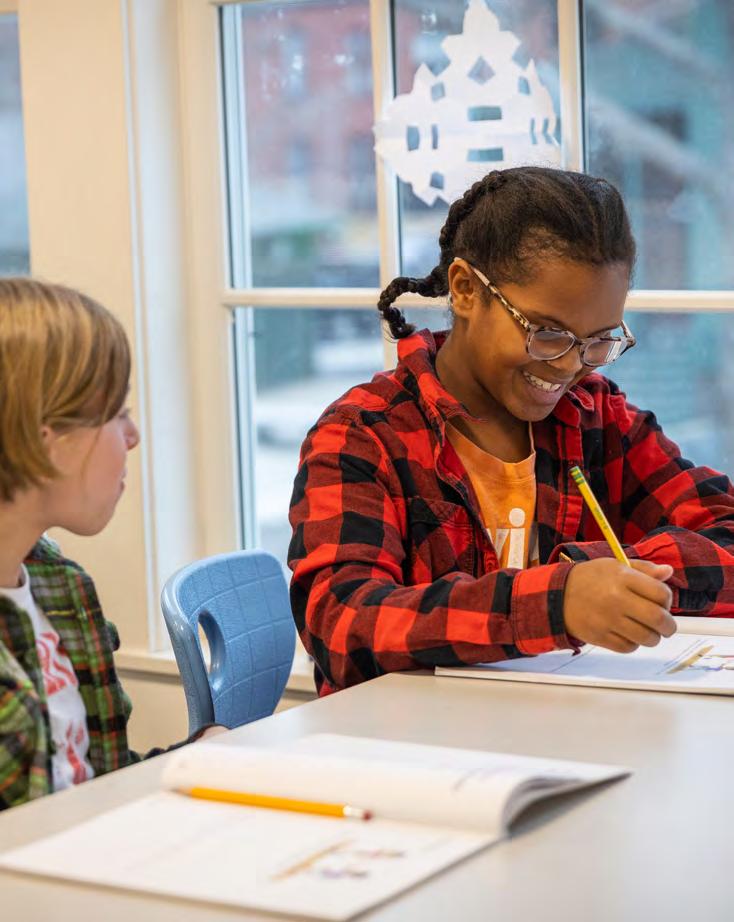
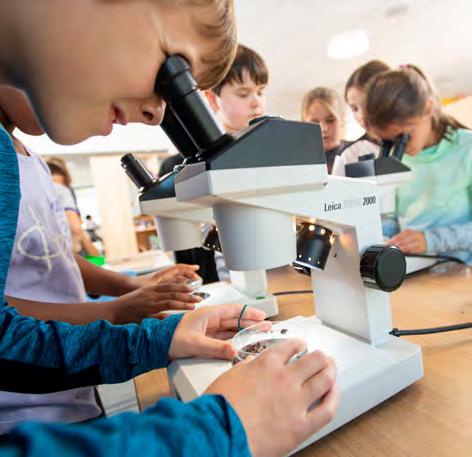
44 4–5
SPANISH
4–5 Spanish marks a shift toward reading, writing, and grammar skills. Students are exposed to two weekly classes of instruction in which much of the teaching occurs in Spanish. With this method, vocabulary and grammar are learned through storytelling and strong imagery. Repetition of high-frequency words allows for advanced language acquisition. Students are encouraged to use as much Spanish as possible in class and are asked to retell their own stories and to reenact scenes from stories and books. Students read in the target language and are encouraged to speak in a mixture of Spanish and English. Students leave the Lower School with an active cultural awareness and a solid foundation for continued language studies in the Middle School.
LIBRARY
4–5 students visit the library weekly by homestation and individually as needed to further develop literacy and research skills and gain independence in using the library. They apply these skills when doing research for class-related projects. Students are introduced to the library’s collection of online research databases as they begin to learn how to locate and evaluate sources in a variety of formats. The library program builds upon students’ natural love of reading by helping them discover a wide range of genres, formats, and themes as they develop their identities as readers. Students may choose to participate in the Maine Student Book Award, a statewide children’s choice reading program that is designed to expand literary horizons of students in grades 4–8 by encouraging them to read, evaluate, and enjoy a selection of new books.
VISUAL ARTS
In 4–5 art, students cultivate personal perspectives of narrative concepts and universal themes. While maintaining a spirit of experimentation, students refine art techniques using a variety of mediums and methods, including paint, clay, drawing materials, printmaking, and collage. The curriculum is designed for creative problem solving while incorporating individual artistic investigation. Historical and contemporary artists are integrated into the curriculum, cultivating an awareness of art as a universal language.
Over the course of the year, students engage in color theory (using primary colors to mix secondary, tertiary, and neutral colors, and reinforcing the ways in which color reflects a feeling or mood); forming clay to create utilitarian or sculptural work; printmaking; and painting with tempera and watercolor. Students draw preliminary sketches as ideas for final projects, conduct observational drawing, and incorporate the elements of art to individual work (and verbally describe artwork). The program further reinforces the definitions of realistic, abstract, and non-objective art styles.
45 4–5
"Students are encouraged to use as much Spanish as possible in class and are asked to retell their own stories and to reenact scenes from stories and books.”
MUSIC
4–5 students focus on both vocal and instrumental technique, along with the broader subject of sound production. Each class works together to interface with musical technologies, discuss the physics of sound, and determine the qualities of a good beat. Students work on practical applications of skills such as rhythm counting in sight reading and composition exercises. Each homestation spends eight weeks with instrumental teachers working on the rudiments of string and wind playing using violins, violas, clarinets, and trumpets.
Throughout the year, students sing and play string, wind, and percussion instruments; compose, document, and perform works individually and in groups; interface with music technology and reflect on the qualities of sound; and perform two-part songs and discuss musical form.
Chorus introduces students to advanced vocal techniques, sound production, and ensemble building as they rehearse for the winter and spring concerts, among other performances. The ensemble performs works in multiple languages and styles, and students work together to create informed and vibrant performances to share with the community.
CREATIVE MOVEMENT/DANCE
4–5 students build skills in awareness and expression while they explore a variety of ways to move, develop muscular strength, and improve coordination, posture, flexibility, stamina, and endurance. Students have the opportunity to be curious and courageous as they grow their appreciation for the performing arts. Through the exploration of the dance elements—space, shape, energy, and rhythm—and the qualities of movement, students express artistic ideas, connect to classroom topics, expand their movement vocabulary, tap into their imaginations, and create and share movement studies inspired by given themes.

46 4–5
"Students have the opportunity to be curious and courageous as they grow their appreciation for the performing arts.”



Frequently Asked Questions
What is offered for Afterschool?
Waynflete offers Lower School families a range of afterschool options, including regular Afterschool programming organized by age group; workshops and enrichment activities in athletics and STEAM; and individual and group music lessons. Afterschool is offered on Mondays, Tuesdays, Thursdays, and Fridays from 3:15–6:00 p.m. All Waynflete students are dismissed at noon on Wednesdays. Afterschool and Enrichment programming runs from noon to 6:00 p.m.
Do students have opportunities to gather with children from other Lower School programs or Middle/Upper School students?

The Lower School program gathers regularly for Pachanga, our community singing and sharing assembly. Songs from the music program; special celebrations for birthdays; Earth Day, May Day, and other holidays; and sharing from the classrooms make this a rich time to connect. Waynflete’s youngest students are paired with older Lower School students and meet regularly during “Buddies” time to read books, collaborate on activities, and participate in community events. A number of Upper School students volunteer weekly in the Lower School classrooms as part of a program called Friends of Founders.
Without standardized tests, what does Waynflete do about grades and reports?
Both formative and summative assessment techniques are employed in the Lower School. Dynamic Indicators of Basic Early Literacy Skills (DIBELS) is the primary tool used for literacy assessment, and the Illustrative Mathematics program incorporates both pre- and post-assessment exercises. Combined with observational data, these diagnostic tools are used to identify student learning needs and to inform instruction and instructional goals. Student progress is communicated in the two teacherfamily conference conversations and three end-of-trimester written reports. Grades are not assigned in Lower School— the reports consist of skills checklists and narrative reporting in each curricular area.
49 FAQ
How can parents be involved in the Lower School?
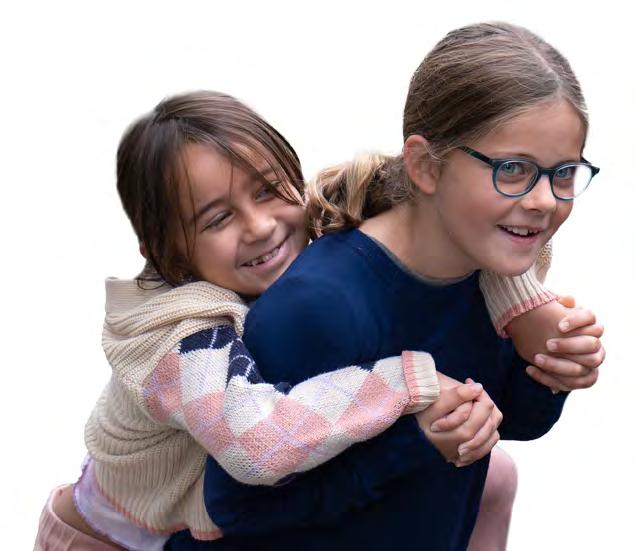
The Waynflete Parents Association is very active in providing ways for parents and guardians to be involved at school. Requests are put out by teachers for help with specific projects and on field trips. Parents are recruited to help out in the Klingenstein Library, with the Halloween Obstacle Course, and during the Lower School Field Day.
How much time do children spend outside?
Lower School children are outside two to three times per day. Snacks and lunch are eaten outside to take advantage of the fresh air and support an efficient transition to recess. We are fortunate to have outstanding natural play spaces surrounding our Lower School in the Upper and Lower Playgrounds. Lower School students frequently visit The Piney Woods and the Fore River Campus.
Do the students take field trips?
Thematic/emergent studies are enhanced by visits from local experts and visits to local landmarks and resources. Students go on field trips to a variety of local playgrounds and play spaces, including the children’s garden at Fort Williams, the Fore River Campus, or Gilsland Farm. Other trips are intended to enhance our understanding of and appreciation for the Greater Portland communities and include local restaurants and businesses, the working waterfront, local beaches, farms, the Portland Museum of Art, and Merrill Auditorium.
How is STEAM integrated into the curriculum?
The integration of science, technology, engineering, arts, and mathematics is well aligned with our interdisciplinary approach to curriculum. All students engage in the Design Thinking process (part of the library’s Novel Engineering program) and when exploring science units, including designing space rovers in K–1, boats in 2–3, and simple machines in 4–5. Coding and fabrication are part of the Lower School curriculum and are available in various clubs as part of the Enrichment program.
50 FAQ

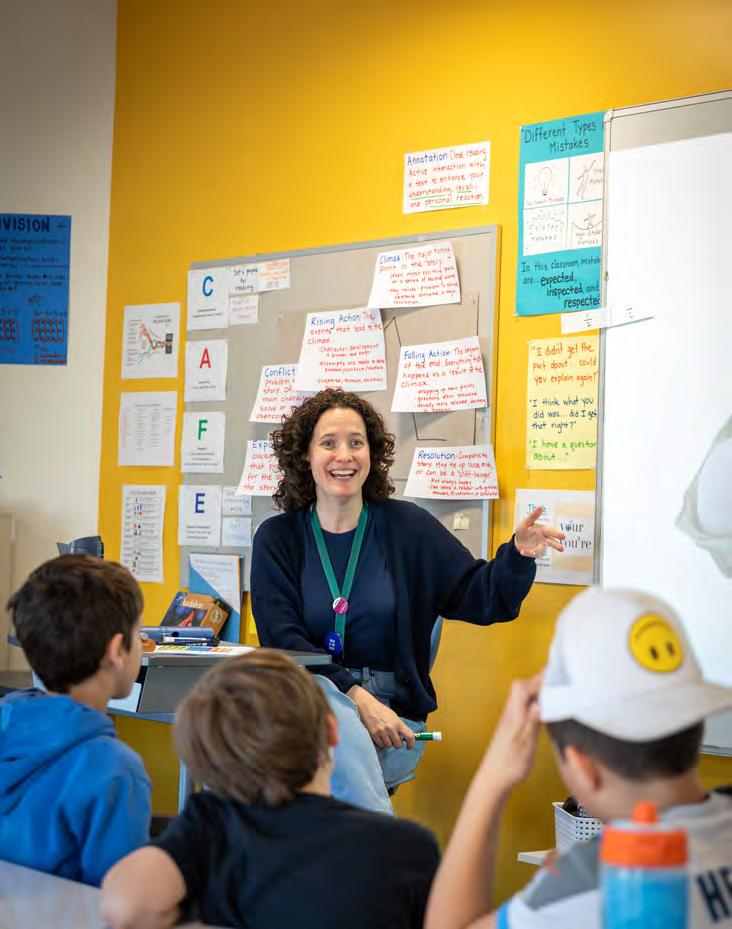
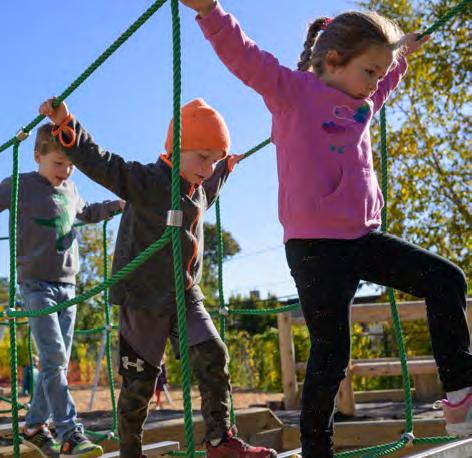
51 FAQ
Testing, evaluation, and academic support
As an independent school, Waynflete goes to great lengths to see that our students are successful in our rigorous academic program. This begins with small classes, engaged advisors, out-of-class support from classroom teachers, and short-term support from the director of support services.
For those students who need more assistance in meeting requirements, the school offers additional academic support at an extra cost to families. In the end, however, there are students for whom the school is not a good match and another learning environment may be in their best interest. The testing and evaluation information requested in the Release of Educational Records section is designed to help the school and parents make informed decisions about the appropriateness of Waynflete for their child.
General Academic Support
Waynflete provides limited academic support for students who, in the school’s opinion, need assistance in meeting Waynflete’s academic standards. This support may include extra help sessions with teachers, short-term assistance from the director of support services (in the area of study skills, executive function, essay writing, lab reports, research papers, and math), the use of assistive technology, and access to supervised free periods. If a student needs more extensive assistance after seeking out classroom teacher assistance, they may request tutoring with a member of the Academic Support faculty. The director of support services can also provide recommendations for outside support services if needed. All requests for tutoring must go through the student’s advisor, the division director, and the director of support services.
Services and Supports Unavailable at Waynflete
Waynflete acknowledges that some students require an array of supports and services in order to be successful. As an independent school, Waynflete provides reasonable accommodations to students with documented learning challenges; however, the school does not provide:
• classroom paraprofessional support such as educational technicians or classroom aides;
• health services beyond the health care set forth in the Waynflete Handbook & Directory;
• certain behavioral interventions, such as formal individual behavioral management plans; or
• related services, such as speech and language, occupational, and physical therapies or an individualized social skills curriculum (some services are available at an additional cost and must be coordinate through the director of support services).
Waynflete does not provide educational or diagnostic testing but may offer to conduct informal screenings for reading, writing, and math. If it appears a child would benefit from formal evaluation, parents are encouraged to contact the director of support services to discuss options
52 TESTING AND SUPPORT
or to obtain a referral list of evaluators in the Greater Portland area. The Portland Public School district may also provide information about evaluation services. Any recommended adjustments to a child’s academic program must be consistent with the criteria outlined and approved by the appropriate division director.
Students with Diagnosed Disabilities
Parents of students who have been evaluated and found to have learning challenges or a diagnosed disability under the Americans with Disabilities Act (including, but not limited to, learning disabilities, ADHD, emotional disorders, and speech and language disorders) may request that Waynflete provide reasonable accommodations. The decision to permit or deny requested accommodations will be made on a case-by-case basis in keeping with the school’s academic program by the director of support services and the appropriate division director. Such decisions will also take into consideration:
• the nature and extent of the child’s documented learning difference;
• all diagnostic, academic, and psychological testing and evaluations;
• academic recommendations from a licensed provider, information generated through the IEP/ISP process by any public educational institution, and the student’s educational history, including behavioral history and prior use of accommodations; and
• whether such accommodations can be provided without undue burden on the school and without fundamentally altering the nature of a program, course, or course of study or lowering standards.
It is essential that documentation of all testing and evaluations be shared with the school and be current (in most cases, conducted within the past three years) for academic accommodations to be approved. If these criteria are met, the director of support services will create an academic or emotional support plan for the student, which will then be shared with the student’s teaching team each year.
Release of Educational Records
As a condition of enrollment consideration, parents must sign a release authorizing the student’s prior school to release all the student’s educational records and to permit Waynflete officials to discuss the student’s educational history with representatives of the previous school. In submitting a student’s educational records, parents must ensure that all diagnostic and educational testing of any kind is provided regardless of whether the testing took place at a prior school or was arranged by parents and conducted by a private evaluator. Withholding educational records may be grounds for termination of the student’s enrollment.
For more information concerning current students, please contact Waynflete’s director of support services at 207.774.5721, ext. 1289.
Prospective families should contact the Waynflete Admission Office at 207.274.5224.
53 FAQ
Waynflete 2023-24 Faculty
Asra Ahmed
Upper School Director
B.A. DePaul University
M.A. University of Chicago
Appointed: 2021
Gary Amara
Academic Support Teacher
B.A. Boston College
Reappointed: 2013
Kathryn Amato
Grades 4–5 Teacher
M.A.T. University of Pittsburgh
M.F.A. Vermont College of Fine Arts
Appointed: 2021
Jonathan Amory
Computer Science and Engineering - Grades 6-12
B.S. Trinity College
M.S. Harvard Design School
Appointed: 2022
Johanna Anderson
School Counselor
B.A. Bates College
M.S.W. University of New England
Appointed: 2021
Emma Bartnick
Computer Science and Engineering - Grades 6-12
Mathematics - Grades 6-12
B.A. Barnard College
Appointed: 2021
Kai W. Bicknell
Early Childhood
B.A. Barnard College
M.S. Lesley University
Appointed: 2003
Pamela L. Brittingham
Academic Support Teacher
B.S. University of Delaware
M.S. University of Southern Maine
Appointed: 1994
Brenda Brush
Academic Support Teacher
B.A. Rutgers College
Appointed: 2015
Elizabeth Burdick
Academic Support Teacher
B.A. Smith College
M.Ed. Boston University
Appointed: 2008
Ross M. Burdick
Athletic Director
B.A. Trinity College - Connecticut
M.S. Hofstra University
Appointed: 2004
Timothy Burris
Academic Support Teacher
Ph.D. Duke University
Appointed: 2023
Denise Calkins
Enrichment Music Instructor
B.A. University of Southern Maine
Appointed: 2012
Thomas E. Campbell Registrar
Mathematics - Grades 6-12
B.A. Bates College
M.S.T. University of New Hampshire
Appointed: 1987
Allison Carswell
Academic Scheduler
Mathematics - Grades 6-12
B.A. Dartmouth College
M.E.T Charles Sposato Graduate School of Education
Appointed: 2022
Christine Caswell
Visual Arts - Grades 6-12
M.F.A. Rochester Institute of Technology
B.F.A. University of Southern Maine
B.A. Keene State College
Appointed: 2020
Kelly Caufield
Enrichment Music Instructor
A.A. Southern Maine
Community College
B.A. University of Southern Maine
Appointed: 2022
Dale Churchill Enrichment Music Instructor
B.A. University of Massachusetts
Appointed: 2007
Lynda Clapp
EC-1 Learning Specialist
Academic Support Teacher
B.A. Rutgers College
M.Ed. Lesley University
Appointed: 2015
Jennifer B. Clarke
Academic Support Teacher
B.A. St. John’s College
Appointed: 1994
Kali Coles
World Languages - Grades 6-12
B.A. University of Montana
B.A. Portland State University
Appointed: 2023
Cathie Connors
Upper School Dean of Students
B.S. Castleton State College Appointed: 1993
Abby Coppins
English Teacher - Grades 9-12
B.A. Princeton University
J.D. University of Connecticut School of Law
Appointed: 2023
Kate Corbett
School Counselor
B.A. Miami University
M.S.W. University of Texas
Graduate School of Social Work
Appointed: 2015
Heather Courtice Hart ’88
World Languages ChairGrades 6-12
B.A. Brown University
M.A. University of Washington
Appointed: 1999
Maegan Crabtree
Assistant Director of Support Services
B.A. University of Southern Maine
M.Ed. University of Southern Maine
Reappointed: 2019
Wendy R. Curtis
Upper School Curriculum
Coordinator
Science - Grades 6-12
B.A. University of Maine
M.S. Massachusetts Institute of Technology
Appointed: 2001
Laurel K. Daly
Lower School Librarian
Co-Curricular Team Coordinator
B.S. University of MaineFarmington
M.L.S. University of Rhode Island
Appointed: 1999
Michael A. Dank
Enrichment Music Instructor Lakeland College
Appointed: 2003
Kristopher Day
Enrichment Music Instructor
University of Southern Maine
Appointed: 2021
James Deterding
Mathematics Department Co-Chair
Mathematics - Grades 6-12
B.A. Calvin College
M.S. Towson University
Appointed: 2018
Stephanie Dolan Science - Grades 6-12
B.Ed. McGill University Appointed: 2010
Cathy C. Douglas
Mathematics - Grades 6-12
B.S. Michigan State University
Appointed: 2004
Nikki Dresser History Department Chair History - Grades 6-12
B.A. Colby College
M.A. University of Southern Maine Appointed: 2015
Doug Durlacher Performing Arts Grades 6-12, Theatre
B.S.W. Shippensburg University of Pennsylvania
M.A. Oklahoma State University Appointed: 2021
Amy Eisenhard
Grades 2–3 Teacher
B.S. Appalachian State University
M.Ed. University of New England
Appointed: 2023
Lauren Eldridge Physical Education - EC-6
B.S. University of Maine-Orono Appointed: 2023
Kimberly Farr Visual Arts - Grades 6-12
B.F.A. University of the Arts
Appointed: 2018
Tiki Fuhro Performing Arts Grades 6-12, Theatre
B.F.A. New York University
Appointed: 1995
54 FACULTY
Sarah Fuller-Matsubara Grades 2–3 Teacher
Team Coordinator
B.A. Boston University
M.S. Bank Street College of Education
Appointed: 2013
Taylor Gaar Science - Grades 6-12
B.A. Whitman College
M.Ed. Harvard Graduate School of Education
Appointed: 2023
Sarah Getchell English - Grades 6-12
B.A. Colby College
M.A. The Bread Loaf School of English
M.F.A. NYU Graduate School of Arts and Science
J.D. University of Michigan Law School
Appointed: 2021
Gene Gill
Performing Arts Grades 4-12, Music Enrichment Music Instructor
B.M. Arizona State University
Appointed: 2019
Michaela R. Goldfine ’90
Grades 2–3 Teacher
B.A. Smith College
M.Ed. Lesley University
Appointed: 1998
Alyssa Goodrich
English - Grades 6-12
B.A. Wheaton College
M.A.T. Boston University
Appointed: 2014
Emily Graham
Co-Dean of Professional Growth
Upper School Librarian
Library Coordinator
B.A. Colby College
M.L.S. Indiana University
Appointed: 2007
Dalit Gulak, RN ’01 Health Coordinator
B.A. University of Delaware
B.S.N. Georgetown University
M.P.H., Boston University
Appointed: 2020
Megan Guynes
World Languages - Lower School
B.A. Bates College
Appointed: 2020
Anna Halat
Math Specialist - Grades EC-6
B.S. University of Wisconsin
M.S.SE University of Southern Maine
Appointed: 2023
Tim Hebda
Co-Dean of Professional Growth
Lower School
Curriculum Coordinator
Grades 4–5 Teacher
B.A. Connecticut College
M.S. University of Southern Maine
Appointed: 2008
Stephanie Hogan
Academic Support Teacher
B.A. Guilford College
Appointed: 2017
John Holdridge
Director, Third Thought Initiatives
B.A. University of Massachusetts
M.Ed. University of Southern Maine
Appointed: 2020
Eddie Holmes
Performing Arts - Grades K-5, Music Enrichment
Music Instructor
B.A. Gettysburg College
Appointed: 2018
Jake Hopkins
Grades 2–3 Teacher
B.Ed. Jordanhill College, Scotland
M.Ed. Lesley University
Appointed: 2020
Anne Scribner Hopkins
Lower School Director
B.A. Trinity College
M.Ed. Lesley University
Appointed: 2017
David Jaffe
World Languages - Grades 6-12
M.A.T. University of Massachusetts, Amherst
B.A. University of Chicago
Appointed: 2020
Lindsay Kaplan
World Languages - Grades 6-12
B.A. Barnard College
M.A. Columbia University, Paris
Ph.D. New York University
Appointed: 2013
Jess Keenan
Grades K–1 Teacher
B.A. Colby College
Appointed: 2007
Debbie Kleinbord
Academic Support Teacher
B.A. Tulane University
M.Ed. George Washington University
M.A.SE American University
Appointed: 2023
Lisa Kramer
Mathematics Department Co-Chair
Mathematics - Grades 6-12
B.A. Bates College
M.Ed. Teachers College, Columbia
Appointed: 2006
Gretchen Lacombe
Grades K–1 Teacher
B.A. University of Southern Maine
M.Ed. University of Southern Maine
Appointed: 2017
Andrew Leach
Assistant Athletic Director
B.S. University of New England
Appointed: 2017
Laura Lennig
English - Grades 6-12
B.A. Emory University
M.A. New York University
Appointed: 1995
Page Lennig
Technology - Grades 6-12
B.S. University of New Hampshire
M.Ed. Lesley University
Appointed 1996
Lisa T. Libby
Mathematics - Grades 6-12
Science - Grades 6-12
B.A. Wheaton College
Appointed: 2002
Jill Marsanskis
Academic Support Teacher
B.S. Boston College
Appointed: 2009
Nancy McAllister
Grades 4–5 Teacher
Team Coordinator
B.A. Bates College
M.Ed. Lesley University
Reappointed: 2004
John McDevitt Middle School Dean of Students Health and Wellness Teacher - Middle School
B.A. Bates College
M.S. University of Southern Maine
Appointed: 2021
Jesse McDonough
History - Grades 6-12
B.A. St. Mary’s College of Maryland
M.Ed. University of New England
Appointed: 2023
Michelle McPherson Miller
World Languages - Grades 6-12
B.S. University of Wisconsin-Madison
B.S. University of Texas at Austin Appointed: 2022
James M. Millard
English - Grades 6-12
B.A. University of New Hampshire
M.Ed. University of Southern Maine
Appointed: 1991
Robert E. Mills
Early Childhood Teacher
Team Coordinator
University of Southern Maine Appointed: 2004
Courtney Morrell History - Grades 6-12
B.A. Bowdoin College
J.D. Suffolk University Law School Appointed: 2022
Jenifer Mueller Director of Auxiliary Programs
B.A. Seton Hall University Appointed 2023
Divya Muralidhara
Middle School Director
English - Grades 6-12
B.A. Wellesley College
M.A. Teachers College, Columbia Appointed: 2007
Leslie Murray
Visual Arts- Grades 6-12
M.A. New York University
B.F.A. Maine College of Art Appointed: 2019
Ralph Nelson
Physical Education - EC-6
B.S. University of Maine
Appointed: 2018
55 FACULTY
Susan Charles Nelson
Performing Arts Grades EC-8, Dance
Enrichment Dance Instructor
B.A. Adelphi University
M.F.A. Dance UNC - Greensboro
Appointed: 1975
Alain Nkulu
EAL Mentor/World Languages
D.V.M. University of Lubumbashi
Appointed: 2010
Sarae Pacetta
Early Childhood Teacher
M.S. Wheelock College
B.S. Boston University
Appointed: 2019
Mary Jane Pagenstecher
Director of Performing Arts, Performing Arts Grades 6-12, Music
B.M.E. University of Nebraska–Lincoln
M.A. Ohio State University
Appointed: 2018
Anya Parauda
History - Grades 6-12
B.A. Colby College
Appointed: 2022
Nora Petroliunas
Performing ArtsGrades 6-12, Dance
B.A. SUNY Purchase College
Appointed: 2022
Meghan Prestes
Grades K–1 Teacher
B.A. University of Massachusetts-Amherst
M.Ed. Lesley University
Appointed: 2023
Cassie Pruyn
English - Grades 6-12
B.A. Bard College
M.F.A. Bennington College
Appointed: 2019
John Radway
English Department Chair
English - Grades 6-12
B.A. Amherst College
A.M. Harvard University
Ph.D. Harvard University
Appointed: 2017
Mary Rehak
Visual Arts - Grades K-5
Team Coordinator
B.F.A. Carnegie Mellon University
M.S. University of Southern Maine
Appointed: 2010
Suzanne Remillard
Enrichment Music Instructor
B.S. University of Southern Maine
Appointed: 2022
Janice S. Ribeiro
World Languages - Grades 6-12
B.A. University of Massachusetts-Amherst
M.A. Middlebury College
Appointed: 2002
Jona Rice
Visual Arts Department Chair
Visual Arts - Grades 6-12
B.F.A. Maine College of Art
Post Bac. Art Education - MECA
Appointed: 2007
Neil Rice Science Department Chair
Science - Grades 6-12
B.S. Duke University
M.S. University of New Haven
Appointed: 2011
Lauren Rioux
Performing Arts Teacher - Strings
B.M. University of Southern Maine
Appointed: 2022
Mesa Robinov ’13
Associate Director of College Counseling
B.A. Brandeis University
M.Ed. Boston College
Appointed: 2022
Morgan Robinson
Early Childhood Teacher
B.S. University of Maine, Orono
M.Ed. University of Maine, Orono
Appointed: 2020
Zoë Romano
Academic Support Teacher
B.A. University of Richmond
M.A. Queens University of Charlotte
Appointed: 2023
Michael Sabin Enrichment Music Instructor - Brass
B.M. New England Conservatory
Appointed: 2022
Whitney Salvail
World Languages - Grades 6-12
B.A. University of Maine
M.A. Universidad de Alcalá
Appointed: 2023
Caroline Sanford
Academic Support Teacher
B.A. University of Georgia
M.A.T Simmons College
Appointed: 2019
Rowena Schenck
Science - Grades 6-12
B.A. Amherst College
M.S. University of Otago
M.Ed. University of Pennsylvania
Appointed: 2023
Sylvia Schwartz
Performing Arts Teacher - Strings
B.S. Franklin W. Olin College of Engineering
M.M. Longy School of Music of Bard College
Appointed: 2022
Stacey L. Sevelowitz
Director of Support Services
B.S. Ithaca College
M.Ed. Cambridge College
Appointed: 2011
Nathaniel Silverson
English - Grades 6-12
History - Grades 6-12
B.A. Middlebury College
M.F.A. University of San Francisco
Appointed 2016
Julia Smith
Grades 4–5 Teacher
B.A. Wesleyan University
M.Ed. Bank Street College of Education
Appointed: 2020
Katrina St. John
Science - Grades 6-12
B.S. Bishop’s University, Quebec
M.S. McGill University
Appointed: 2009
Jane Strauch
Mathematics - Grades 6-12
B.A. Yale University
M.Ed. High Meadows Graduate School of Teaching and Learning
Appointed: 2023
Samuel Stuart Middle School Librarian
Afterschool Teacher
B.S. St. Michael’s College
M.L.S. Kent State University
Appointed: 2020
Heather L. Tanguay
2–3 Learning Consultant
Academic Support Teacher
B.A. Smith College
M.Ed. University of Southern Maine
Appointed: 2000
Stacie Thomas
Grades K–1 Teacher
Team Coordinator
B.S. University of MaineFarmington
Reappointed: 2009
John Thurston
Director of College Counseling
B.A. Carleton College
M.F.A. University of Southern Maine
Appointed: 2014
David A. Vaughan
Science - Grades 6-12
B.A. Colby College
M.F.S. Yale University
Reappointed: 2008
Andrew Voorhees
History - Grades 6-12
B.A. Ithaca College
M.A. Brown University
Appointed: 2022
Geoffrey Wagg Head of School
B.A. Connecticut College
M.Ed. Teachers College, Columbia
Appointed: 2013
Nicole Wiesendanger
History - Grades 6-12
B.A. University of Southern Maine
M.Ed. St. Joseph’s College
Appointed: 2021
Steven Withers
Mathematics - Grades 6-12
B.S. Bloomsburg University
M.Ed. Bloomsburg University
Appointed: 2014
Otis Wortley ’09
World Languages - Grades 6-12
B.A. Kenyon College
Appointed: 2020
Kathryn Ziminsky
SEL Consultant
B.A. St. Michael’s College
Reappointed: 2009
Whitney (Huiru) Zou
World Languages - Grades 6-12
B.A. Wuhan University (China)
M.Ma. Massey University (New Zealand)
Appointed: 2014
56 FACULTY

360 Spring Street, Portland, ME 04102 207.274.5224 waynflete.org










 DRAMA
DRAMA


































